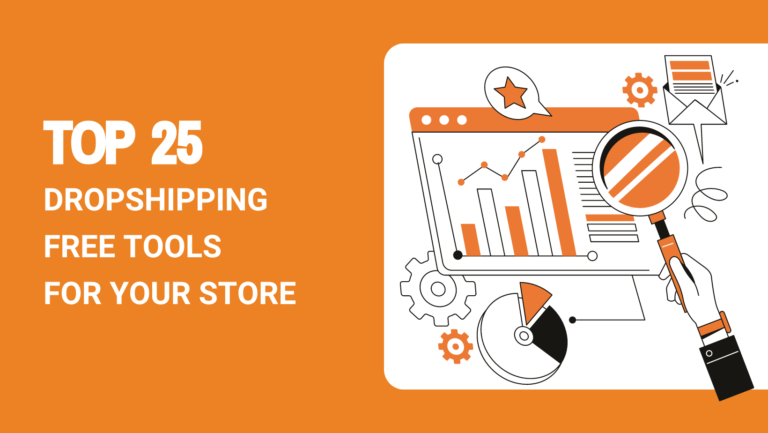The right tools can make or break your dropshipping business. From product sourcing to marketing, automation, and analytics, every stage of your store’s workflow benefits from using the right digital helpers.
The best part? Many of them are completely free.
In this updated 2025 guide, we’ve rounded up the top free dropshipping tools that can help you research winning products, manage orders, design visuals, and optimize your store’s performance, without eating into your profits.
Whether you’re a beginner launching your first Shopify store or an experienced seller scaling multiple channels, these tools will help you save time, cut costs, and run your business more efficiently.
E-commerce Platform (for Store Setup)
1. WooCommerce
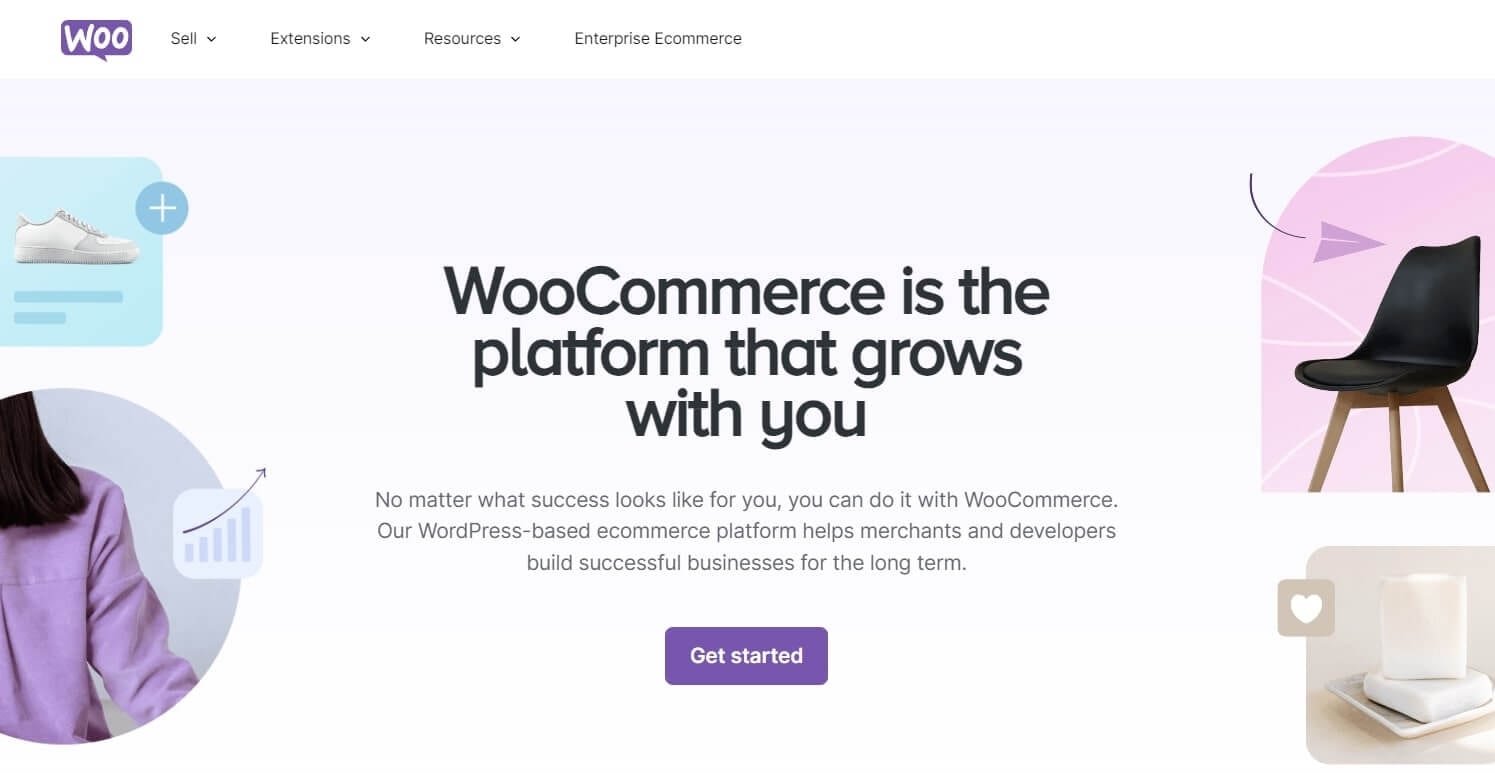
WooCommerce is an open-source ecommerce platform that transforms any WordPress site into a fully functional online store.
It’s highly customizable and scalable, making it ideal for dropshippers who want flexibility and full control.
Because it’s self-hosted, you own your data and can shape the customer experience without platform restrictions.
WooCommerce supports a wide range of dropshipping plugins and integrations, allowing easy connection to suppliers and automated order fulfillment.
Its large community and extensive documentation make setup and troubleshooting accessible, even for beginners.
Key Features
- Customizable storefront with thousands of free and paid themes and plugins
- Integrations for dropshipping platforms like AliExpress and Printful
- Built-in inventory, product, and order management tools
- Multiple payment gateways including PayPal and Stripe
- SEO-friendly foundation powered by WordPress
Pros
- Free core plugin lowers the barrier to entry
- Highly extensible through plugins and themes
- Large, active community for support and resources
- Full ownership of store data and design
Cons
- Requires separate hosting and maintenance
- Steeper learning curve for non-technical users
- Plugin conflicts may occur with multiple extensions
- No dedicated customer support (community-based)
Pricing
WooCommerce itself is free. You’ll need to cover web hosting and optionally purchase premium plugins or themes. Most dropshippers can start with minimal costs, scaling up as the store grows.
Design & Branding Tools
2. Canva
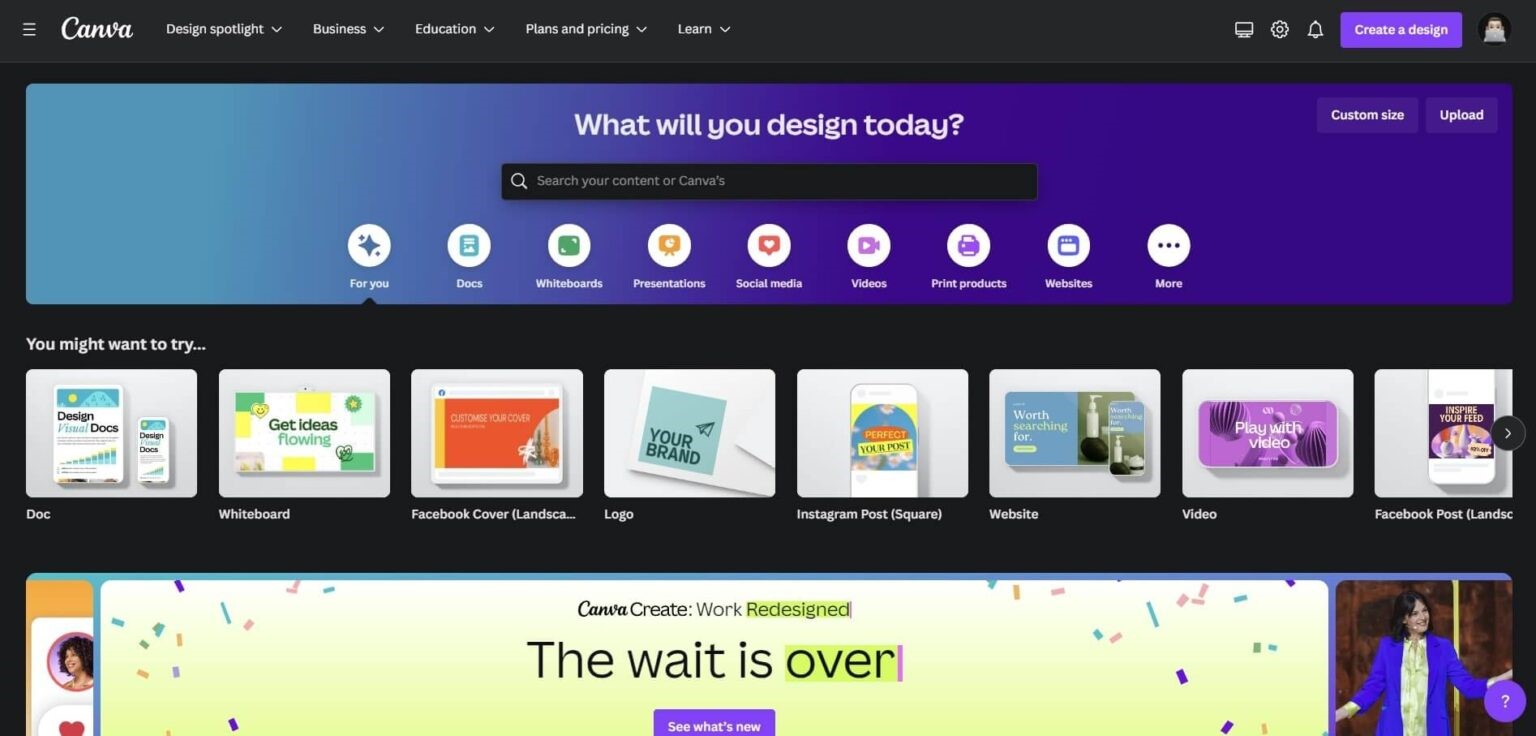
Canva is a user-friendly design platform that lets dropshippers create professional graphics without any design background.
Its drag-and-drop interface and massive template library cover everything from social media posts to ads and product visuals.
In 2025, Canva has continued expanding into AI-powered tools like Magic Write, brand automation, and text-to-image generation, making it an all-in-one design solution for ecommerce businesses.
The platform ensures your visuals stay polished, consistent, and brand-aligned across all marketing channels.
Key Features
- Thousands of ready-made templates for logos, ads, and videos
- Drag-and-drop editor with stock photos, fonts, and icons
- Real-time team collaboration and commenting
- Brand Kit to save your logo, fonts, and colors
- Integrations with Google Drive, Dropbox, and social media
Pros
- Intuitive interface suitable for beginners
- Robust free plan with many usable templates
- Frequent updates introducing AI and automation features
- Ideal for small businesses needing fast, consistent visuals
Cons
- Premium features (background remover, resizer, etc.) require Pro
- Common templates can look generic without customization
- Limited vector or advanced editing options
- Internet connection required for most functionality
Pricing
Free plan available with thousands of templates. The Pro plan (around $12.99/month) adds premium elements, advanced features, and brand management tools. Most dropshippers start free and upgrade as design needs evolve.
3. Hatchful
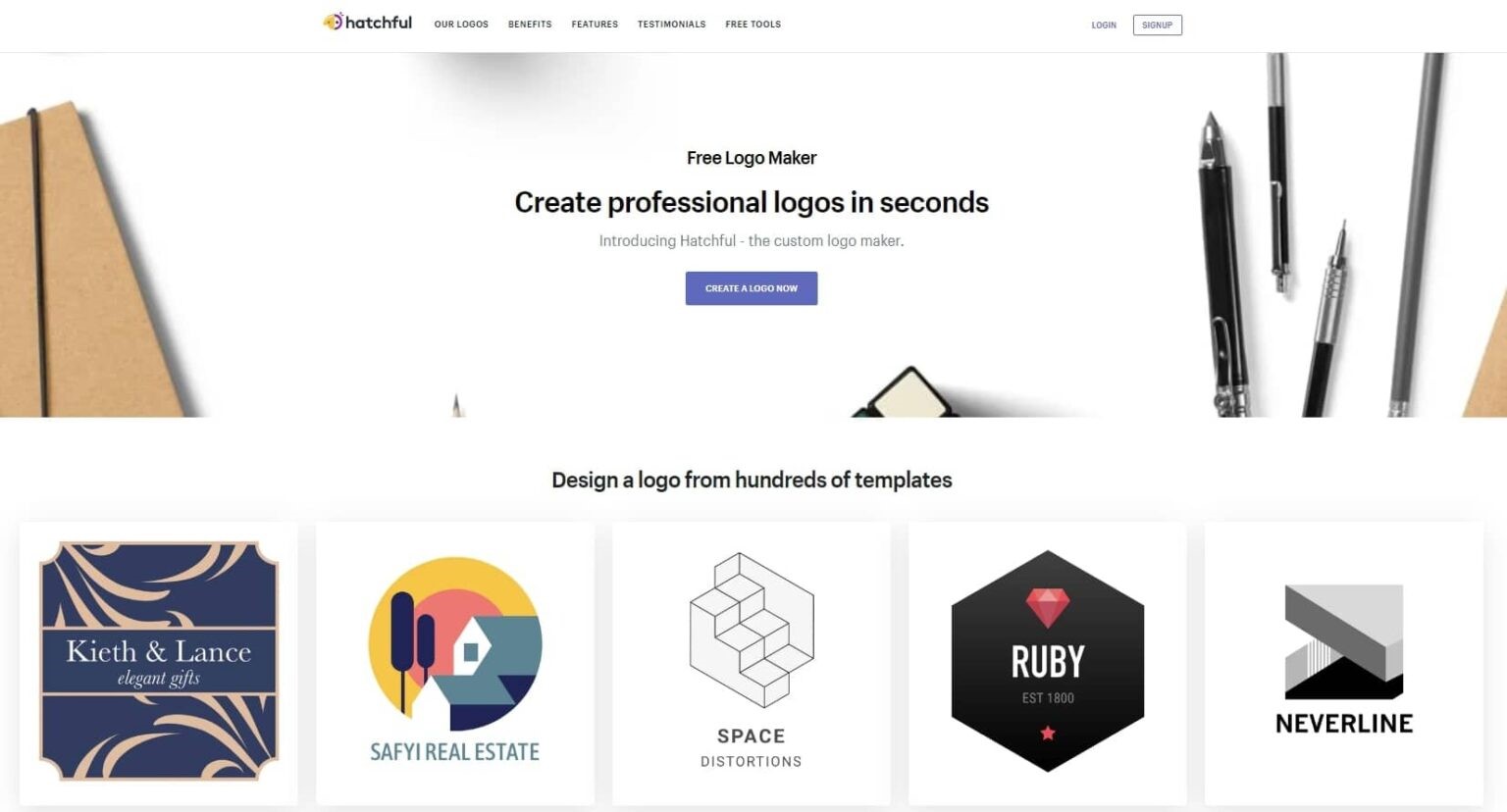
Hatchful is a free logo-making tool created by Shopify to help new business owners design brand identities quickly.
It asks a few questions about your niche and style, then generates logo concepts that can be customized with colors, fonts, and icons.
Hatchful simplifies the branding process for dropshippers who want a professional look without hiring a designer.
The final logos are ready for both digital and print use, helping your store look credible right from launch.
Key Features
- Hundreds of logo templates across various industries
- Easy customization for color, font, and layout
- Industry-specific design recommendations
- High-resolution logo downloads and social media sizes
- Beginner-friendly guided design process
Pros
- Completely free to use and download logos
- Fast branding solution for new stores
- Provides print-ready, high-resolution files
- Intuitive and beginner-friendly interface
Cons
- Templates may lead to similar-looking designs
- Limited customization compared to professional software
- Focuses solely on logos, not full brand kits
- Works best within Shopify’s ecosystem
Pricing
Hatchful is entirely free, with no subscription required. Logos can be designed, customized, and downloaded at no cost, perfect for startups working on tight budgets.
Product Research Tools
4. Google Trends
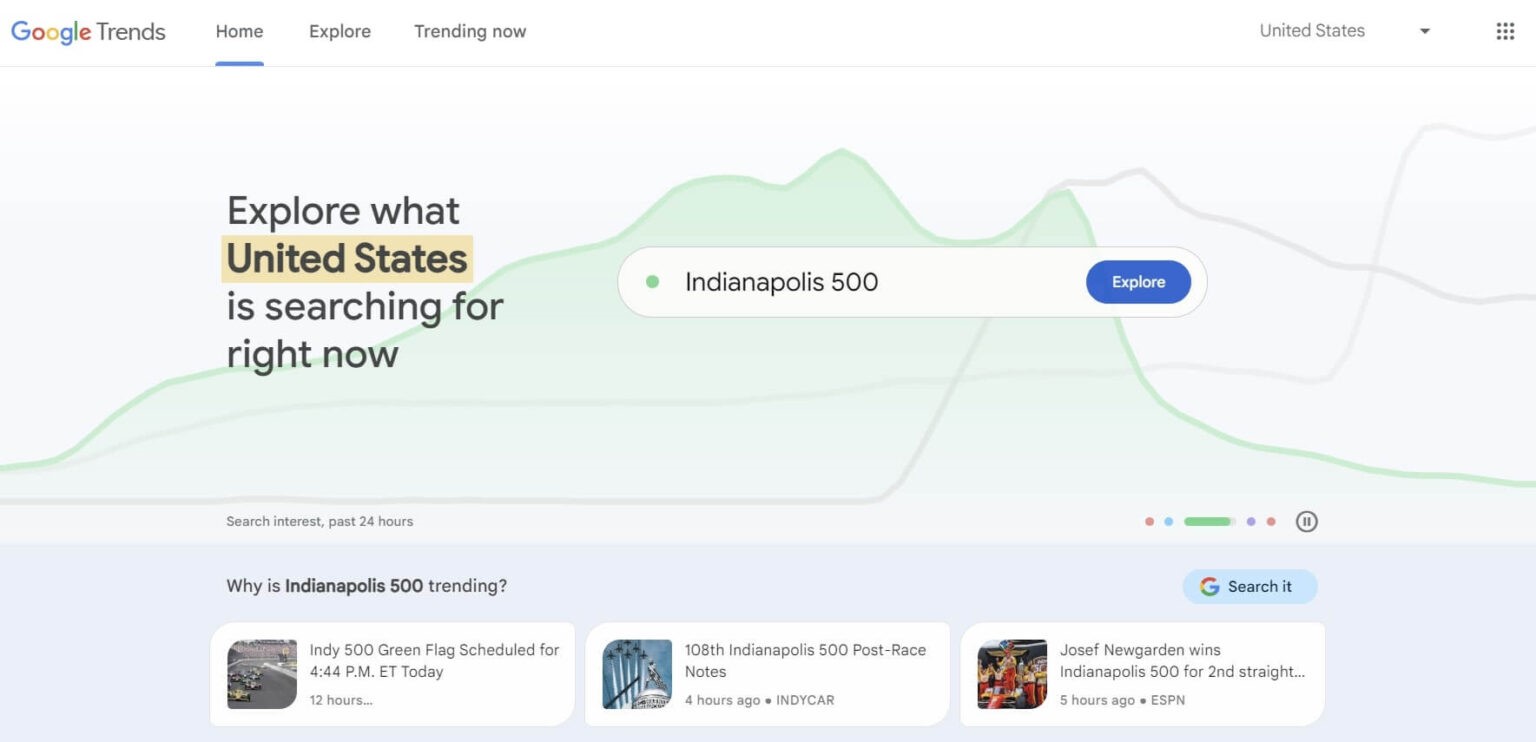
Google Trends is a powerful, free research tool that tracks the popularity of search queries over time. For dropshippers, it helps gauge product seasonality and spot rising niches before they peak.
By comparing multiple keywords, you can quickly see which products are gaining traction and which are declining.
It’s not a sales analytics tool, but it provides valuable insight into consumer interest and can guide product selection with real-time and historical search data.
Key Features
- View search interest over time for any keyword
- Filter by region, time frame, or category for targeted insights
- Discover related queries and trending search terms
- Compare multiple keywords side by side
- Access both real-time and long-term trend data
Pros
- Completely free with unlimited use
- Clear visual graphs and maps for easy interpretation
- Ideal for spotting emerging products early
- No login required for quick access
Cons
- Shows relative popularity, not exact search volumes
- Doesn’t include sales or conversion data
- Broad insights, requires further validation with other tools
- Limited data for small or niche keywords
Pricing
Free. All features are available without any paid upgrades or restrictions.
5. Shine Commerce
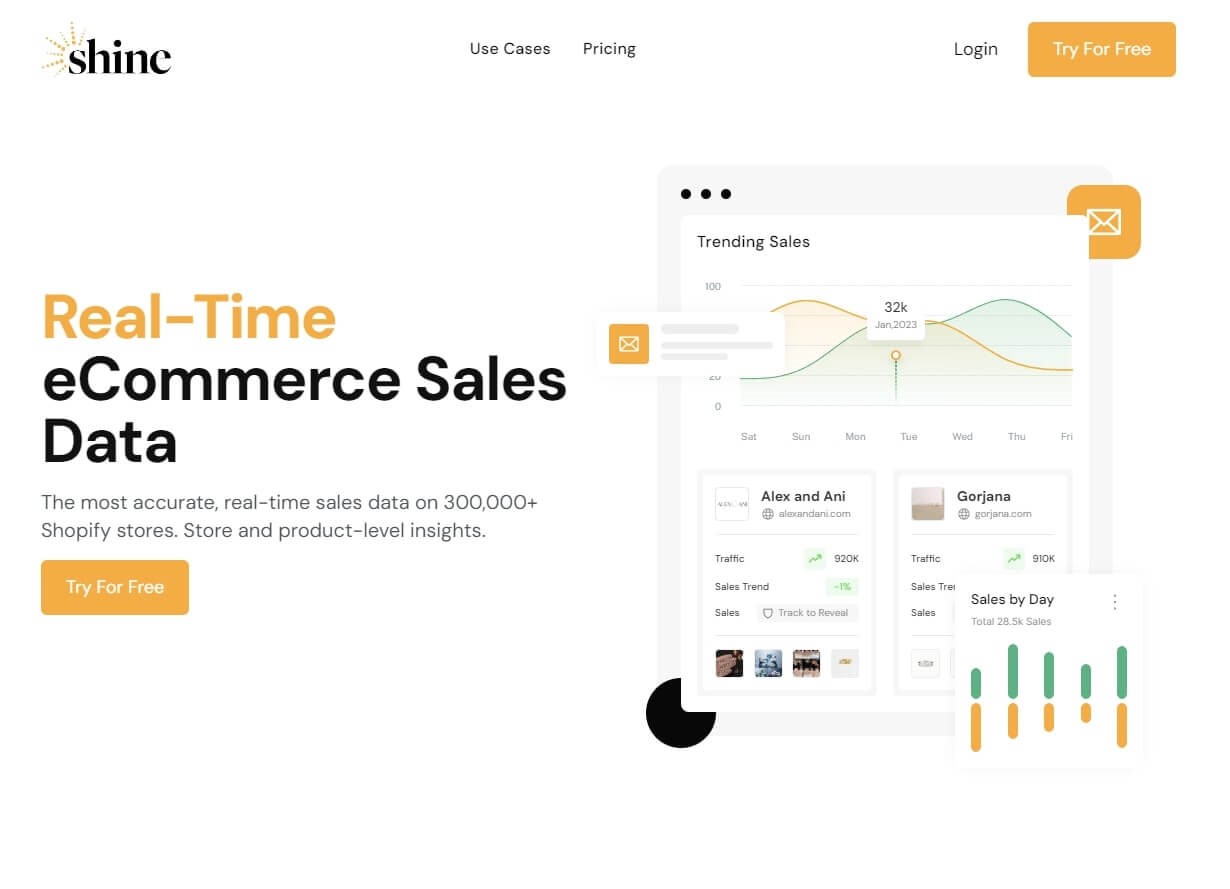
Shine Commerce (formerly Commerce Inspector) is a competitor intelligence and ecommerce market research platform.
It allows dropshippers to analyze Shopify stores and gain insights into their sales estimates, top products, and marketing channels.
By revealing what other successful stores are selling, Shine helps validate product ideas and uncover emerging niches backed by real performance data.
Key Features
- Access estimated sales data for over 300,000 Shopify stores
- View best-selling and newly added products
- Track traffic sources and ad strategies
- Detect apps used by competitor stores
- Frequent data updates for fresh insights
Pros
- Helps identify proven, high-performing products
- Data-backed validation of market trends
- Clean and intuitive dashboard
- Useful for benchmarking or store valuation
Cons
- Primarily covers Shopify stores only
- Sales data is estimated, not exact
- Information density can overwhelm beginners
- Premium plans required for deeper data
Pricing
Free basic access with limited data. Paid plans unlock advanced analytics, additional stores, and more frequent updates.
6. Exploding Topics
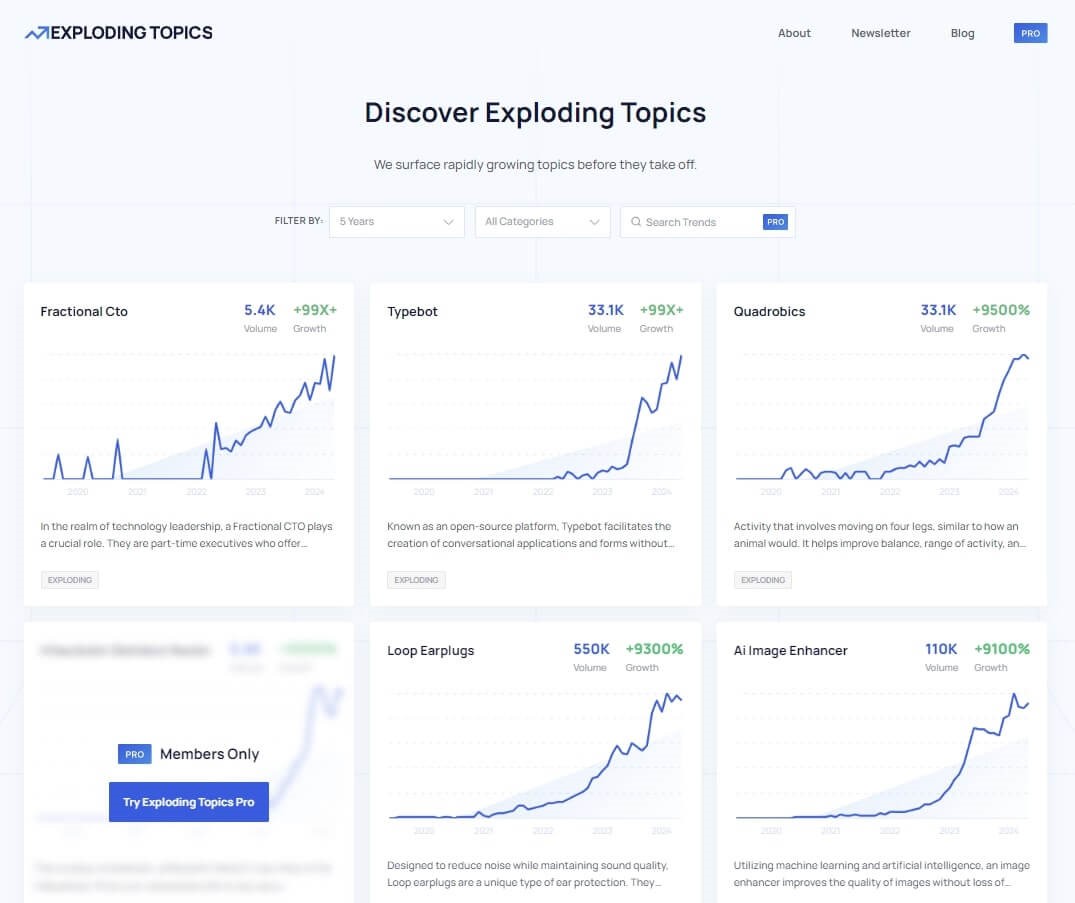
Exploding Topics identifies fast-rising products and trends before they hit the mainstream.
It scans the web for keywords, search surges, and mentions to surface “exploding” topics, perfect for finding new product opportunities early.
Dropshippers can use it to stay ahead of demand curves and discover niches before competitors flood the market.
Key Features
- Curated list of rapidly growing topics and products
- Category filters for ecommerce-friendly niches
- Growth charts and brief descriptions for each trend
- Weekly trend reports via email
- Pro version with deeper data and historical tracking
Pros
- Great for early trend detection
- Simple interface with actionable insights
- Generates creative product and niche ideas
- Free version available for basic use
Cons
- Topics can be broad and require interpretation
- Once public, trends can become saturated fast
- Doesn’t provide sales or sourcing data
- Limited results on free plan
Pricing
Free plan available for trend browsing. Pro version (subscription-based) unlocks deeper data, longer trend history, and keyword exports.
7. Dropship.me
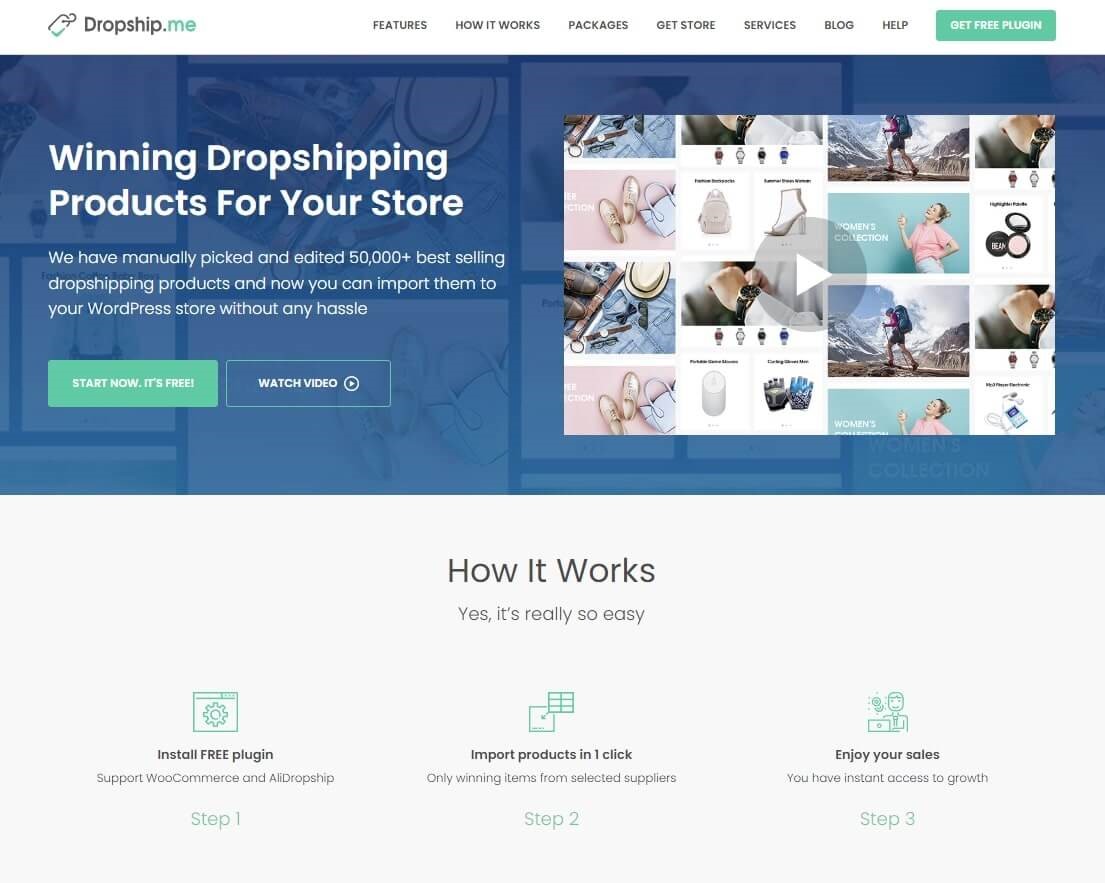
Dropship.me is a curated product sourcing plugin for WordPress and WooCommerce users.
It provides access to a handpicked catalog of top-performing AliExpress products, each with optimized titles, descriptions, and supplier details.
By focusing on proven winners, it helps beginners save time on product research and launch their stores faster with ready-to-import items.
Key Features
- Curated catalog of 50,000+ proven AliExpress products
- Optimized SEO-friendly titles and descriptions
- One-click product import to WooCommerce
- Built-in supplier rating and performance check
- Search and filter by keyword or niche
Pros
- Saves significant research time
- Beginner-friendly setup for new stores
- Professionally written listings for better conversions
- Free tier allows limited imports
Cons
- Only works with WordPress/WooCommerce
- Limited selection compared to full AliExpress catalog
- Competition possible from shared product pool
- Must pay for larger import packages
Pricing
Free plugin with limited imports (e.g., up to 50 products). One-time paid packages are available for higher import limits.
8. Minea
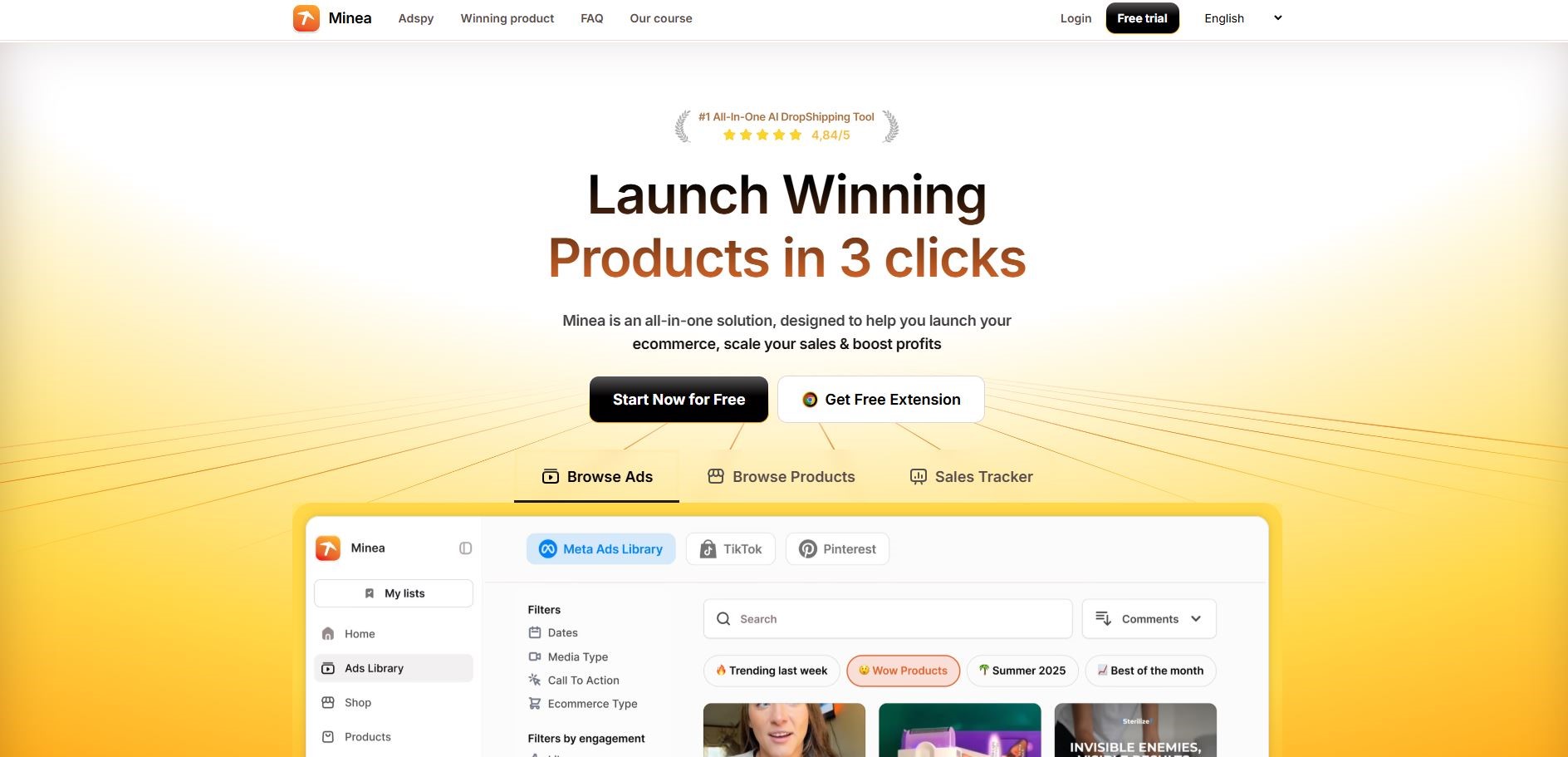
Minea is one of the most popular new product research and ad intelligence tools of 2024–2025.
It tracks millions of ecommerce ads across Facebook, Instagram, TikTok, and Pinterest, allowing dropshippers to identify trending products and analyze ad performance.
Beyond ad spying, Minea also helps uncover winning creatives, top-performing stores, and marketing strategies, making it a versatile research and inspiration hub.
Key Features
- Massive ad database across multiple social platforms
- Advanced search filters by niche, region, and engagement
- “Winning Products” section with direct sourcing info
- Competitor analysis of stores and ad strategies
- Chrome extension and ad tracker for ongoing monitoring
Pros
- Comprehensive ad coverage across major networks
- Reveals real-world winning products and creatives
- Saves ad testing time and budget
- User-friendly interface with powerful filters
Cons
- Subscription-based (free trial is limited)
- Learning curve for complex filters
- Market saturation risk for popular discoveries
- Estimates only, sales data not guaranteed
Pricing
Free trial available with limited credits. Paid plans typically start around $29–$49/month, with higher tiers offering deeper data, longer history, and multi-user access.
Product Sourcing & Fulfillment Tools
9. CJdropshipping
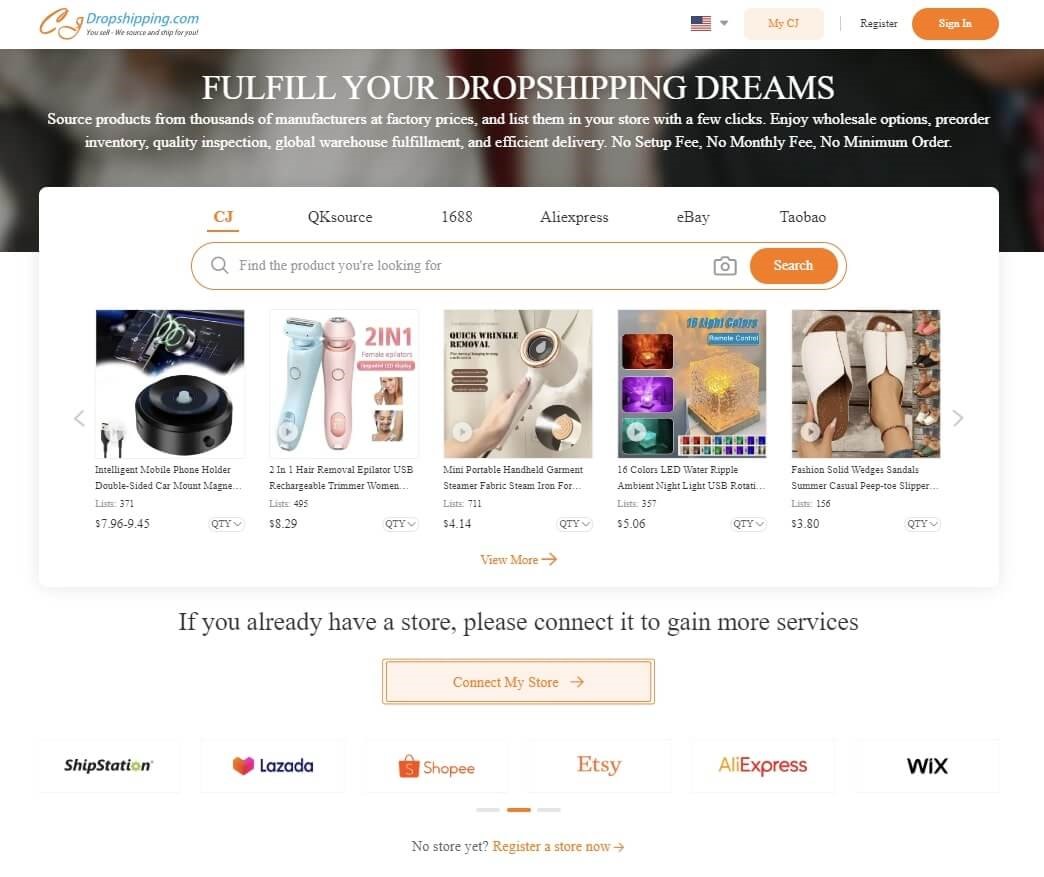
CJdropshipping is a full-service sourcing and fulfillment platform built for modern dropshippers.
It connects sellers with thousands of verified suppliers and millions of products across categories, offering everything from product sourcing to automated order fulfillment.
With multiple warehouses across the US, EU, and Asia, CJ helps reduce delivery times while offering additional services like private labeling, branding, and print-on-demand (CJ POD).
It’s one of the most comprehensive tools for managing the entire sourcing-to-shipping workflow.
Key Features
- Vast catalog of millions of products across various categories
- Global warehouses in over 10 countries for faster regional shipping
- Seamless integration with Shopify, WooCommerce, and eBay
- Automated fulfillment with synced tracking and order updates
- Branding options and print-on-demand services
Pros
- Free to use with no monthly or setup fees
- Combines sourcing, fulfillment, and branding in one platform
- Offers product quality checks and dedicated agent support
- Constantly updated with new features and trending products
Cons
- Complex interface with a learning curve for new users
- Shipping speed varies depending on warehouse availability
- Works best with CJ’s Chrome extension for full functionality
- Occasional product or pricing fluctuations
Pricing
Free to use. You only pay for product and shipping costs per order. Optional services, like custom packaging, product videos, or warehousing, may include additional fees. Overall, CJ is a budget-friendly and scalable choice for startups and growing stores alike.
10. AliExpress
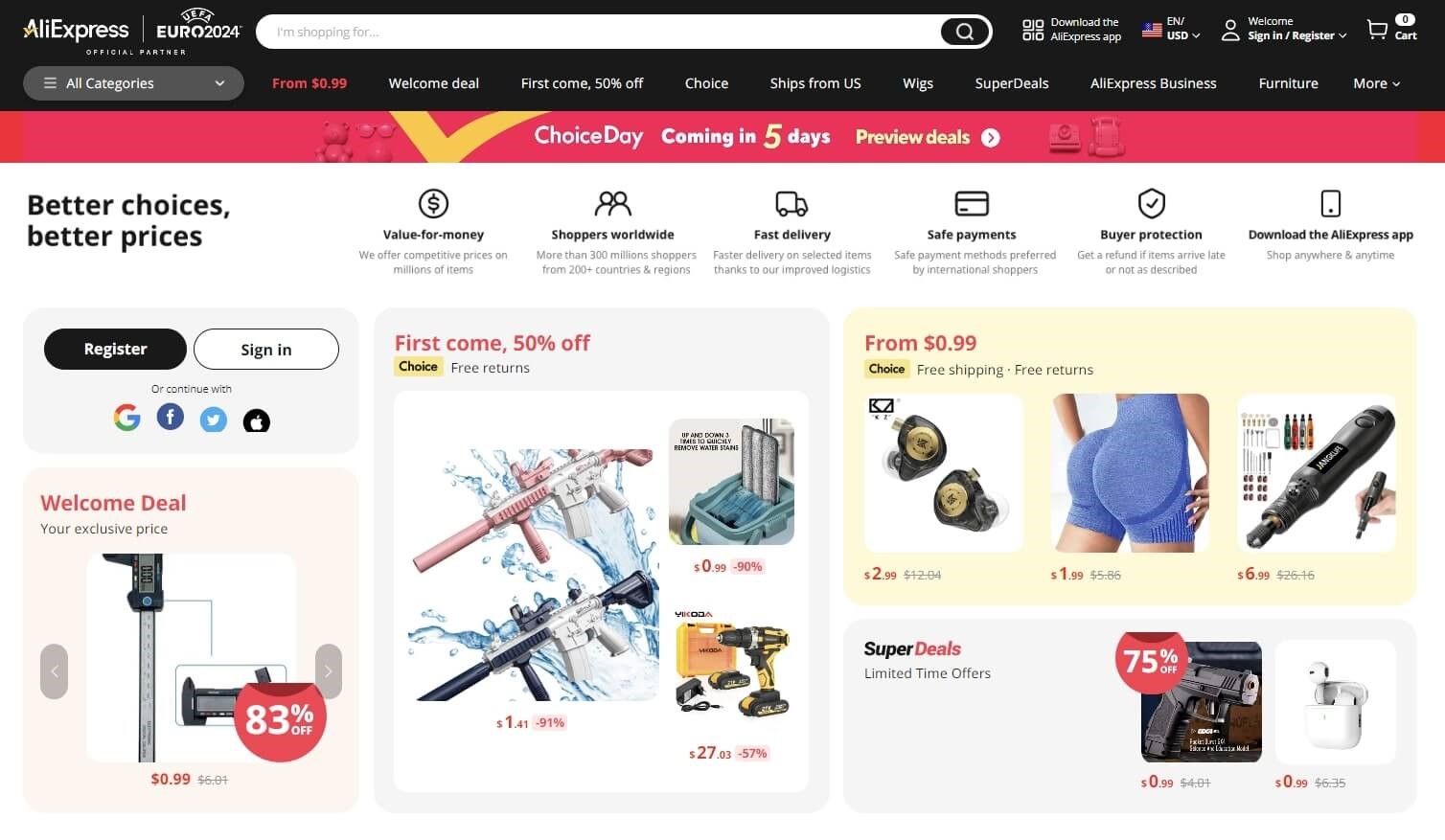
AliExpress remains one of the most widely used marketplaces for dropshipping. Owned by Alibaba, it offers millions of products directly from manufacturers at competitive prices.
Dropshippers can easily list items from AliExpress in their stores and have them shipped directly to customers once purchased.
The platform’s large product selection, buyer protection program, and seller review system make it a trusted global source, though success often depends on careful supplier selection.
Key Features
- Millions of products spanning every niche and price range
- Buyer protection that safeguards against fraud or non-delivery
- Global shipping to 200+ countries
- Seller ratings and verified buyer reviews
- Frequent sales events and wholesale discounts
Pros
- Free to browse and start selling, no upfront costs
- Vast product selection for testing multiple niches
- Integrates with automation tools like DSers
- Competitive wholesale-like pricing
Cons
- Long shipping times for non-local suppliers
- Varying quality and reliability among sellers
- Limited branding or packaging control
- Customer communication can be challenging
Pricing
Completely free to use. You pay per order for the product and its shipping. Pricing varies by supplier and shipping method, with no subscription or platform fees.
11. DSers
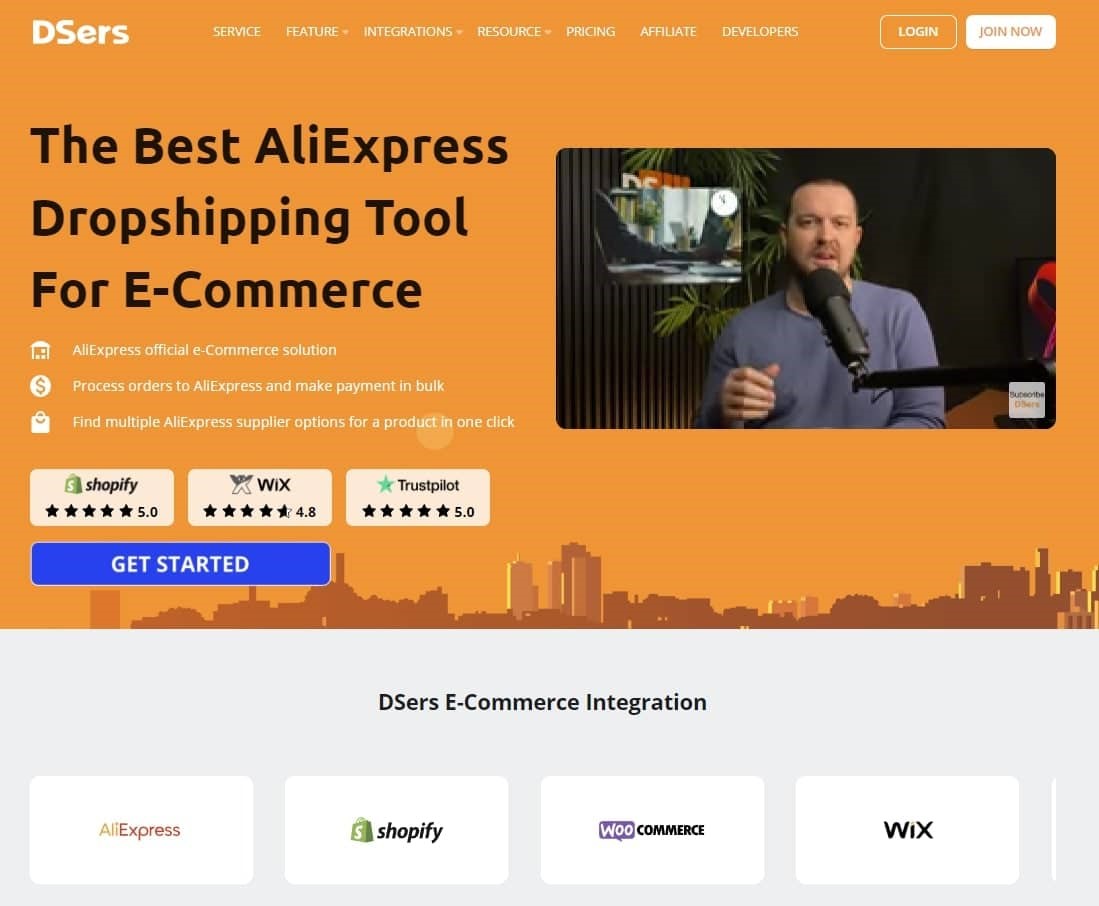
DSers is an official AliExpress partner tool that automates the fulfillment process for dropshippers.
It enables bulk order placement, real-time tracking updates, and supplier optimization, all designed to reduce manual effort and increase efficiency.
DSers effectively replaced Oberlo as the go-to AliExpress automation solution, allowing sellers to scale their stores easily while maintaining control over fulfillment workflows.
Key Features
- Bulk order processing for hundreds of AliExpress orders
- Supplier optimizer for switching between vendors
- Automatic tracking number sync and customer updates
- Product bundling and split-order management
- Multi-store management from one dashboard
Pros
- Automates repetitive order processing tasks
- Minimizes risk of out-of-stock products via alternate suppliers
- Official AliExpress partnership offers VIP supplier pricing
- Built for high-volume stores needing scalable solutions
Cons
- Limited to AliExpress-based suppliers
- Requires setup time for product mapping and fulfillment rules
- Advanced features take time to master
- Occasionally impacted by AliExpress system changes
Pricing
Free basic plan available. Paid plans (Advanced, Pro, Enterprise) range from about $19.90 to $49.90 per month, unlocking advanced supplier features, multiple store connections, and expanded order limits.
12. Printful
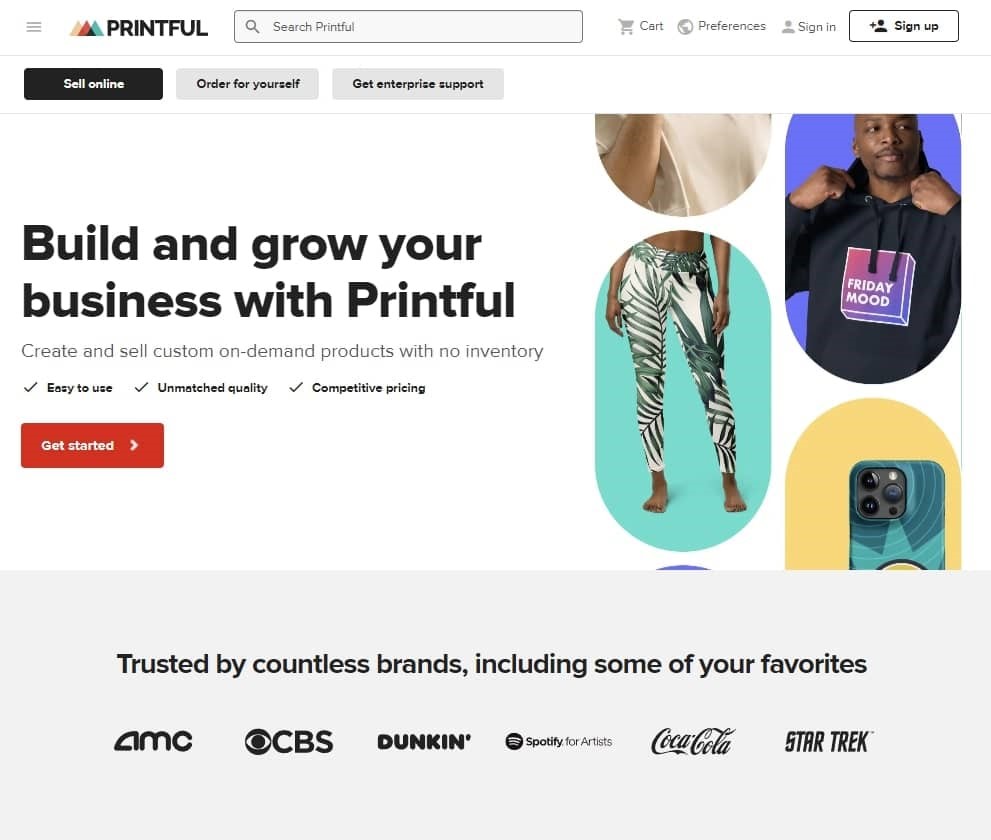
Printful is a leading print-on-demand (POD) fulfillment platform that enables you to sell custom-designed products without holding inventory.
It automatically prints, packs, and ships items like t-shirts, mugs, wall art, and hoodies directly to your customers once an order is placed.
With fulfillment centers across North America, Europe, and Asia, Printful ensures quality production and faster shipping while helping sellers expand into branded merchandise.
Key Features
- 300+ customizable product options
- Intuitive design and mockup generator
- Integration with Shopify, Etsy, WooCommerce, and more
- Automated production and fulfillment with tracking updates
- Branding options such as custom labels and packaging inserts
Pros
- No inventory or upfront investment required
- High-quality printing and reliable fulfillment network
- Seamless integration with major ecommerce platforms
- Scalable operations suitable for both small and large stores
Cons
- Higher product base costs reduce per-item profit
- Limited to supported printing methods and product types
- Occasional stock availability issues
- Shipping setup can be complex for stores with mixed product types
Pricing
Free to use. You pay the base product cost, printing fee, and shipping for each order. Optional upgrades, like custom branding or design services, are available for additional cost.
13. Zendrop
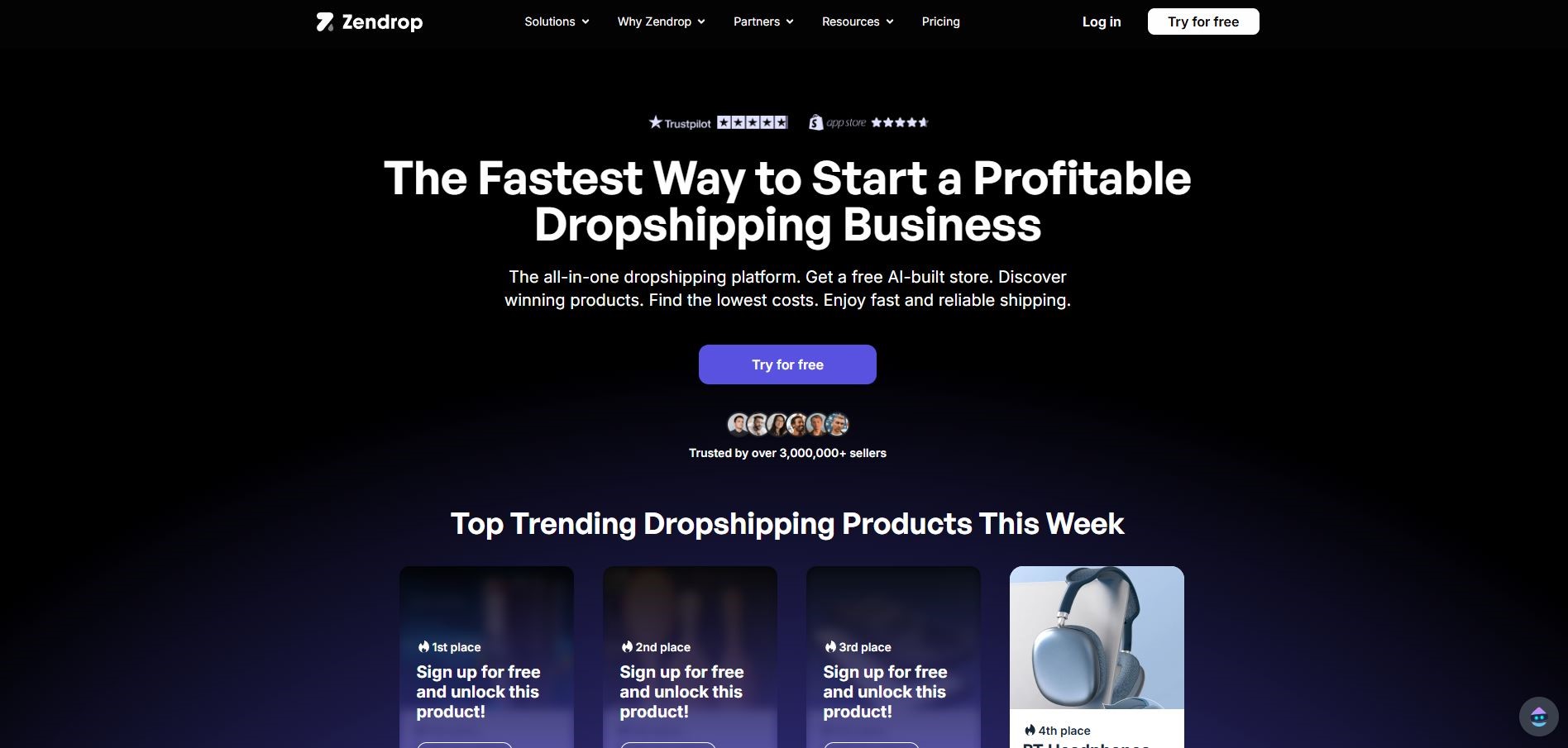
Zendrop is an emerging all-in-one fulfillment and product sourcing solution gaining popularity among dropshippers in 2024-2025.
It focuses on speed, branding, and customer experience, offering faster global shipping, private labeling, and real-time inventory syncing.
Zendrop also includes product recommendations, automation tools, and built-in analytics to help users identify winning products and streamline their logistics, all from a modern, user-friendly interface.
Key Features
- Product catalog curated for trending and high-quality items
- Fast shipping from US and international warehouses
- Branding options like custom packaging and invoices
- Automated order syncing and tracking
- Analytics dashboard for sales and performance insights
Pros
- Faster fulfillment times than most China-based suppliers
- Sleek, beginner-friendly interface with guided onboarding
- Private labeling and branding features for improved customer experience
- Built-in tools for discovering trending products
Cons
- Limited free plan; advanced features require subscription
- Smaller product catalog compared to AliExpress or CJ
- Newer platform with a smaller supplier network
Pricing
Free plan available for basic product sourcing. Paid plans start at around $49/month, unlocking faster fulfillment, custom branding, and access to premium products and analytics.
Product Sourcing & Fulfillment Tools
14. Google Keyword Planner
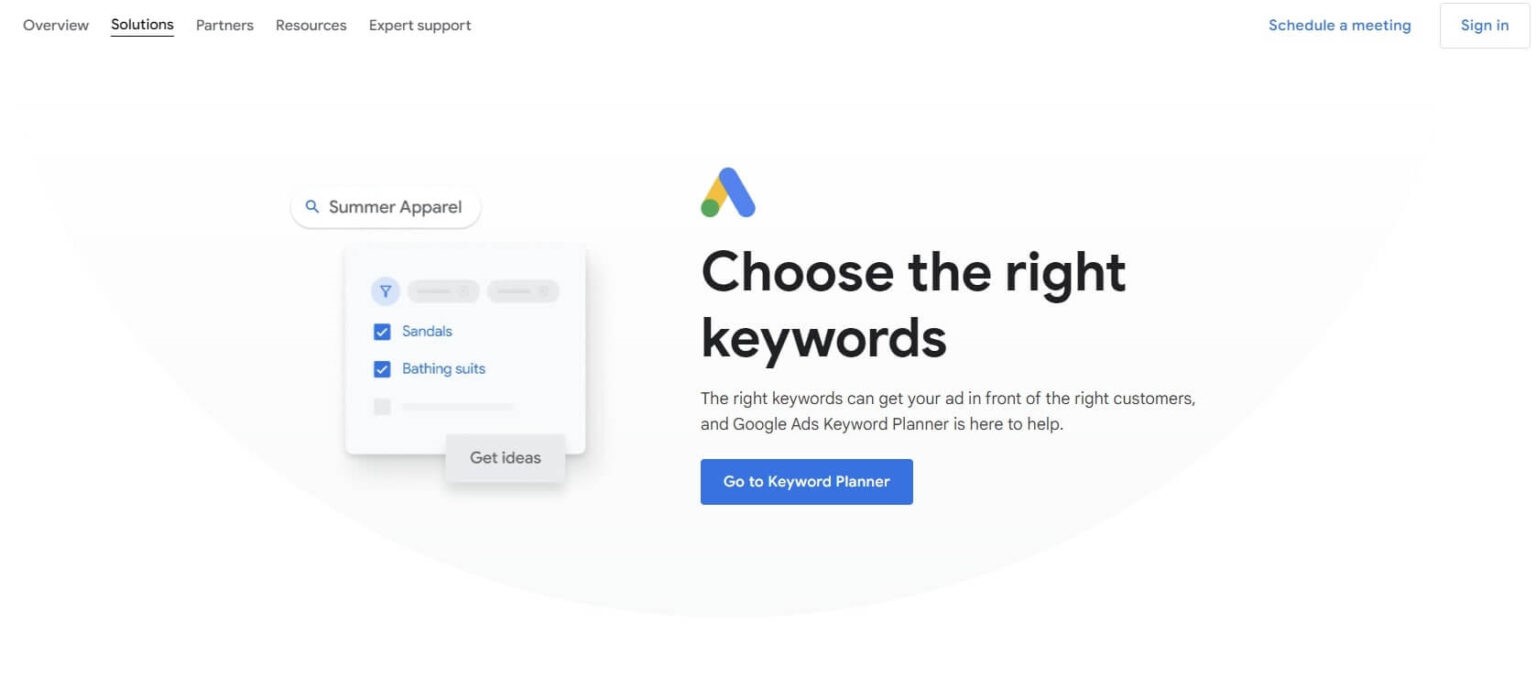
Google Keyword Planner is a keyword research tool within Google Ads that helps you discover relevant keywords, analyze search volumes, and assess competition.
For dropshippers, it’s invaluable for both SEO and PPC, you can identify what potential customers are searching for and strategically target those terms in your product listings or ad campaigns.
By understanding search intent, you can align your marketing messages with what people are actively looking for.
Key Features
- Discover keyword ideas based on product names or categories
- View monthly search volumes and competition levels
- Get cost-per-click (CPC) estimates for paid ad campaigns
- Analyze seasonal trends for product demand
- Filter and refine keyword lists for more focused targeting
Pros
- Direct data from Google ensures accuracy and reliability
- Useful for both SEO optimization and PPC planning
- Completely free to use with a Google Ads account
- Helps uncover long-tail and niche-specific keywords
Cons
- Requires a Google Ads account setup
- Search volume data often shown in broad ranges
- Focused only on Google search (not social or marketplace data)
- Some suggested keywords may not fit your exact intent
Pricing
Free to use. No subscription or spending requirement, though full data access works best with an active Google Ads account. Ideal for beginners looking for cost-free keyword insights.
15. Ubersuggest
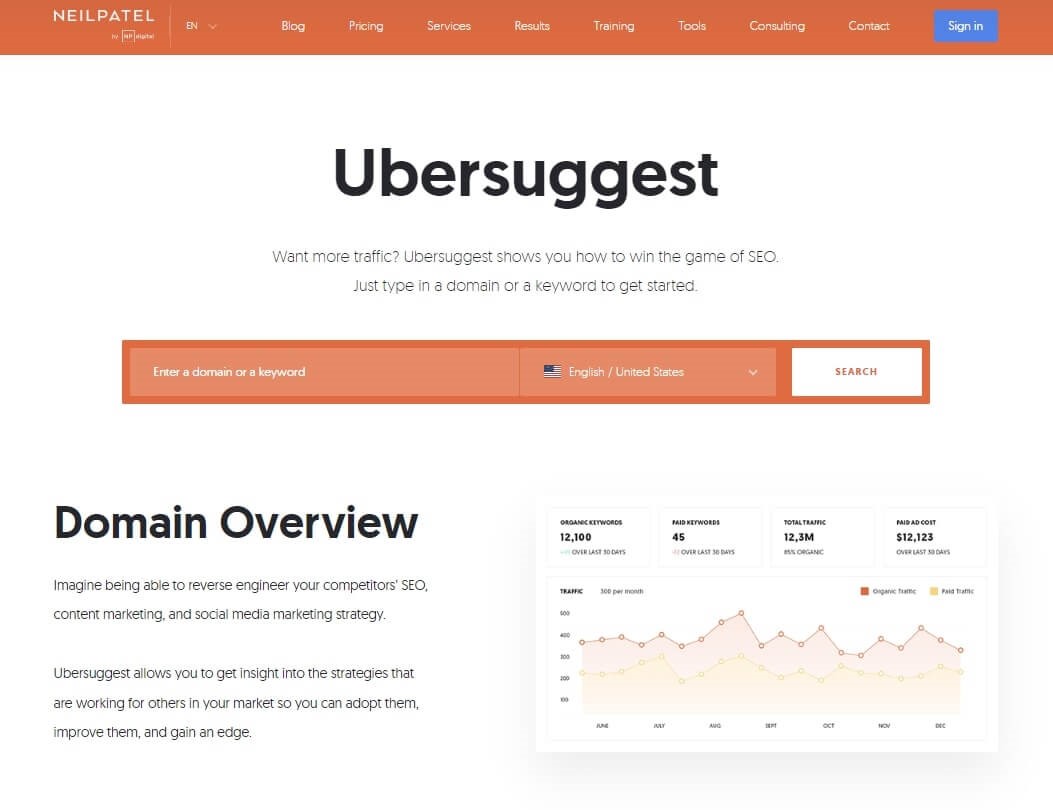
Ubersuggest is an SEO and content marketing tool developed by Neil Patel.
It helps you identify high-traffic keywords, analyze competitors’ top pages, and discover content ideas to improve your organic reach.
For dropshippers, it’s especially handy for finding profitable niches and understanding how competing stores drive traffic through SEO.
Key Features
- Keyword research with search volume and difficulty metrics
- Competitor domain analysis to reveal top-ranking pages
- Content idea generator based on popular topics and backlinks
- Basic backlink analysis for link-building opportunities
- Website SEO audit and optimization recommendations
Pros
- Beginner-friendly interface with clear explanations
- Combines multiple SEO functions in one platform
- Regular updates and trend insights
- Affordable pricing and occasional lifetime deals
Cons
- Smaller data set than enterprise SEO tools (Ahrefs, SEMrush)
- Limited daily searches on free plan
- Accuracy varies slightly for traffic and keyword metrics
- Includes light marketing for Neil Patel’s ecosystem
Pricing
Free plan with limited searches. Paid plans start around $29/month and include more keyword lookups, competitor tracking, and SEO audits. One of the most affordable all-in-one SEO tools for small ecommerce stores.
16. Later
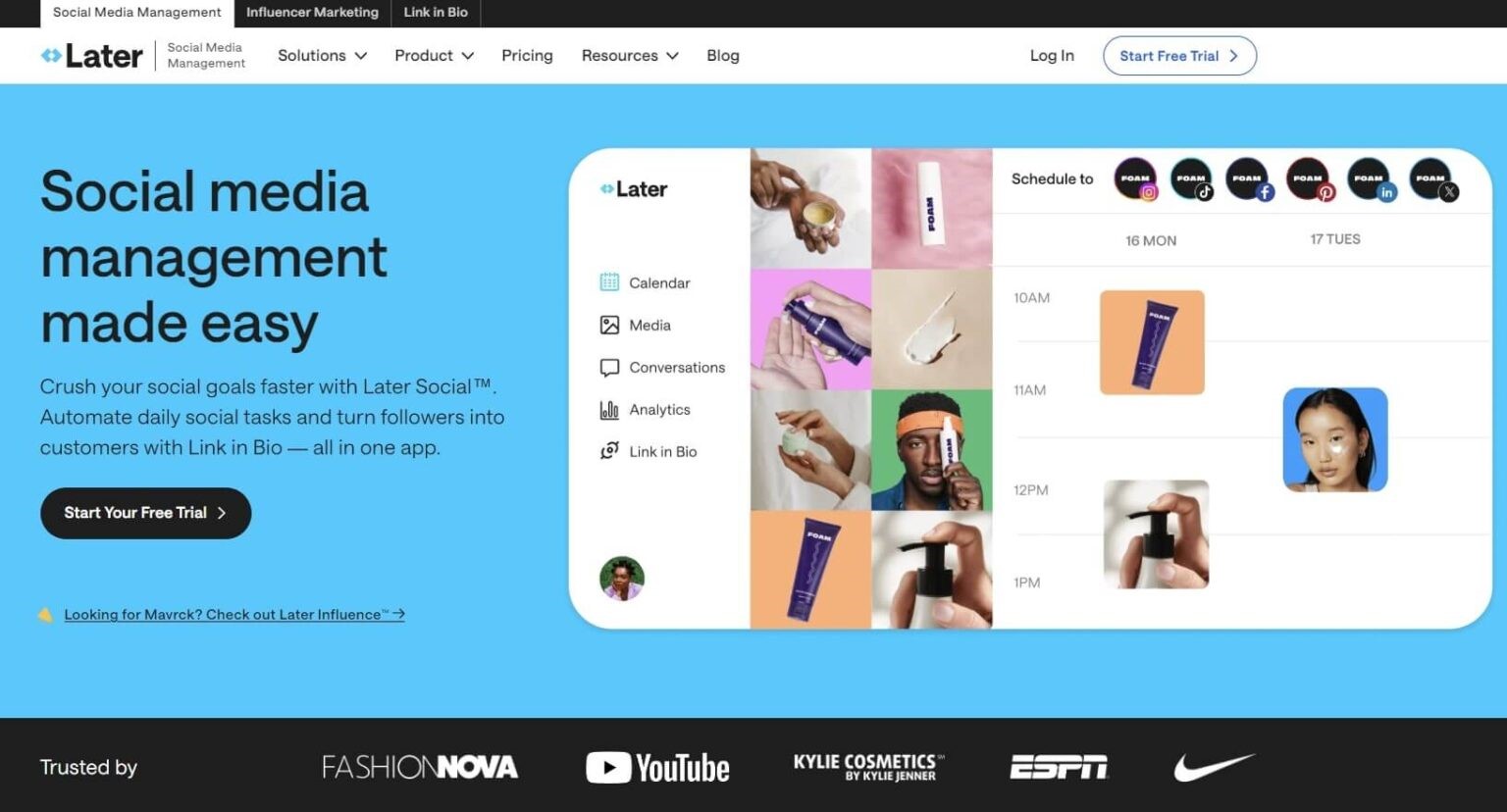
Later is a social media management platform that helps you plan, schedule, and analyze your content across multiple platforms like Instagram, TikTok, Facebook, and Pinterest.
It’s especially popular among ecommerce brands that rely on visual storytelling.
With Later, you can batch-schedule content, maintain brand consistency, and track engagement, all from a single dashboard.
Key Features
- Visual content calendar for post planning and scheduling
- Auto-publishing to major platforms (including TikTok and Reels)
- “Link in Bio” feature to drive clicks from Instagram posts
- Performance analytics for engagement and growth
- Multi-platform content management in one place
Pros
- Saves time through automated scheduling
- Ideal for maintaining a consistent brand aesthetic
- Intuitive visual planner suited for ecommerce stores
- Free plan available for testing basic features
Cons
- Limited scheduling and profiles on the free plan
- Analytics less detailed than specialized tools
- Some features depend on API restrictions (e.g., Instagram Stories)
- Small learning curve for new users
Pricing
Free plan available with limited posts. Paid plans start around $18/month (billed annually), scaling up to $80/month for additional profiles and analytics. A solid mid-range option for stores focused on consistent social media growth.
17. Omnisend
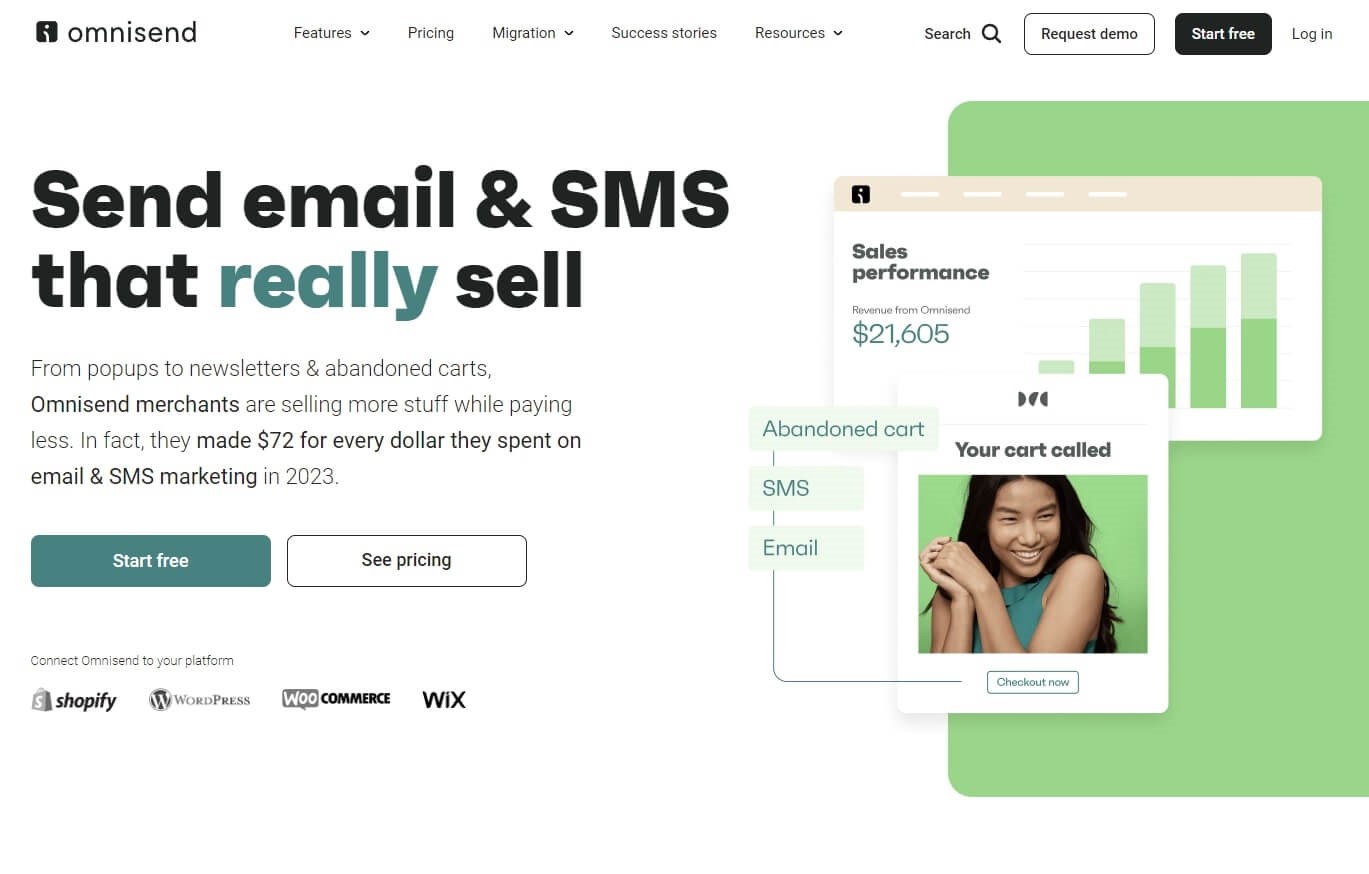
Omnisend is an ecommerce-focused marketing automation tool for email, SMS, and push notifications.
It helps online stores increase sales through personalized, automated communication, like welcome sequences, abandoned cart reminders, and order follow-ups.
Its integrations with platforms like Shopify and WooCommerce make setup simple and effective for dropshippers.
Key Features
- Drag-and-drop email builder with ecommerce elements
- Prebuilt automation workflows (cart recovery, welcome series, etc.)
- Audience segmentation based on behavior and purchase history
- Multichannel messaging (email, SMS, push notifications)
- Detailed campaign reports and attribution analytics
Pros
- Tailored specifically for ecommerce stores
- Automation features drive higher conversions on autopilot
- Combines multiple marketing channels in one tool
- Easy migration from other platforms like Mailchimp
Cons
- Free plan limited in contacts and monthly sends
- Pricing scales with list size and SMS usage
- Advanced automation setup takes time to learn
- Template customization options could be more flexible
Pricing
Free plan available for small lists. Paid plans start around $16/month for up to 500 contacts. The Pro plan (around $59/month) adds SMS credits and advanced reporting. Costs rise with contact volume but remain competitive for the feature set.
18. Rytr
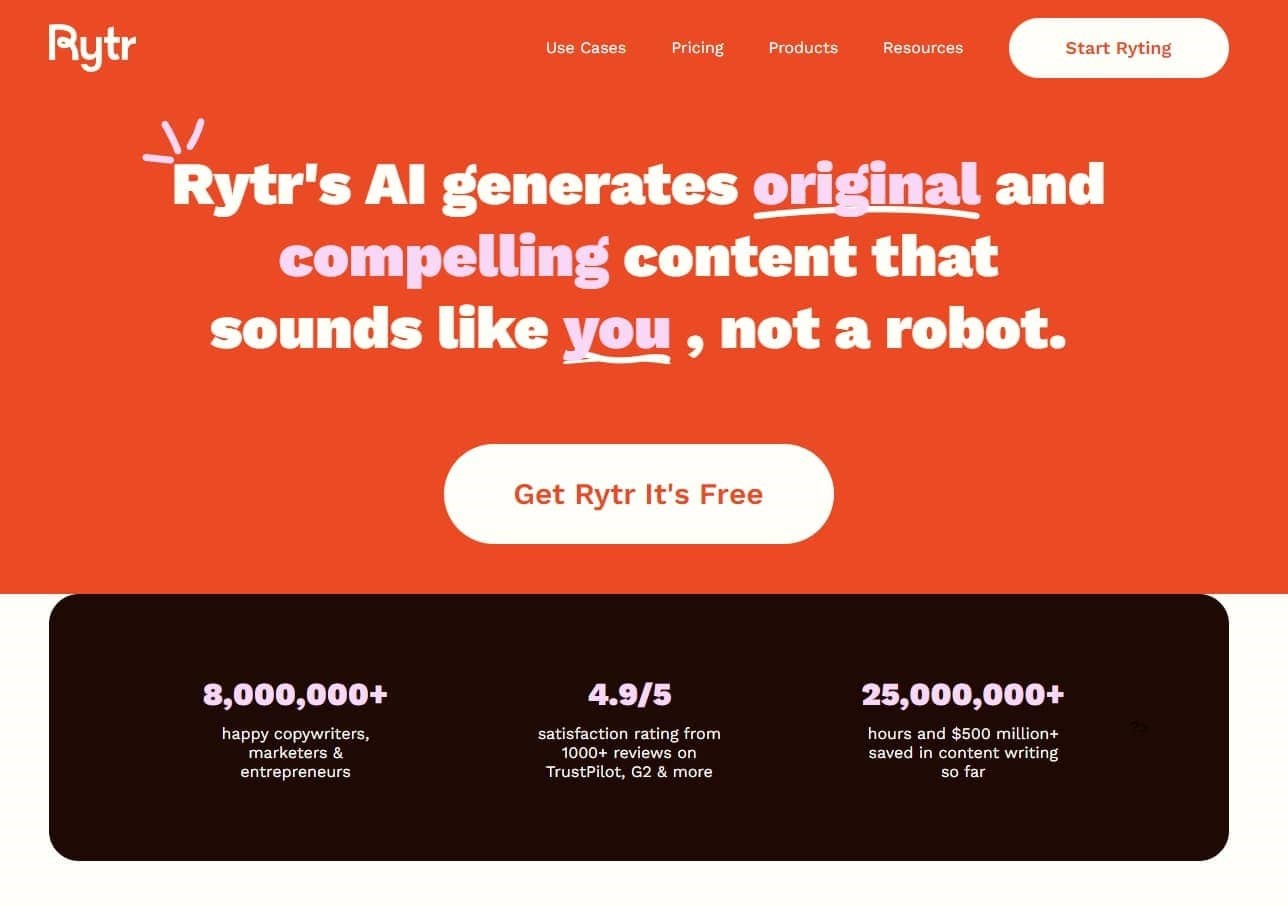
Rytr is an AI writing assistant that helps you generate product descriptions, ad copy, and social captions within seconds.
Designed for small business owners and marketers, it speeds up content creation while maintaining quality and tone consistency.
Dropshippers can use it to create SEO-friendly product listings and promotional material without hiring a writer.
Key Features
- 40+ content templates for ads, descriptions, emails, and blogs
- 20+ tone options (e.g., friendly, persuasive, professional)
- Multilingual support for global audiences
- Built-in plagiarism checker
- Browser extension for quick content editing anywhere
Pros
- Produces content quickly and efficiently
- Very affordable compared to human copywriters
- User-friendly for beginners
- Constantly improving with new features and templates
Cons
- Occasional generic or inaccurate outputs
- Limited monthly usage on free plan
- Struggles with highly technical or niche topics
- May require editing to match brand tone perfectly
Pricing
Free plan with a limited monthly quota. Paid plans start at $9/month (Saver) and $29/month (Unlimited). All features are included on all plans, the main difference is usage volume.
19. Grammarly
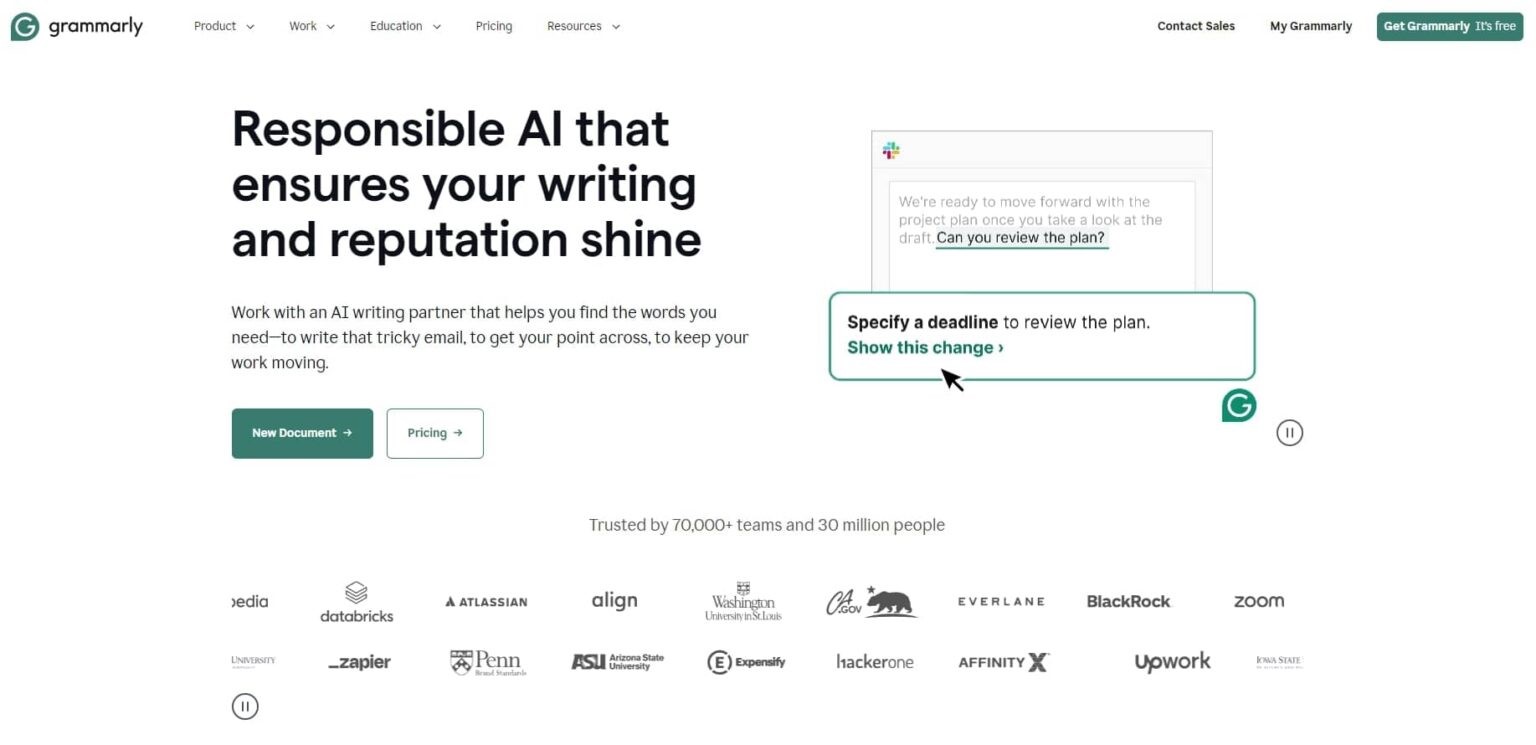
Grammarly is a writing assistant that checks spelling, grammar, and tone to ensure your content reads clearly and professionally.
It’s an essential tool for dropshippers who write product descriptions, emails, and ads, helping you maintain credibility and polish in all communications.
Key Features
- Real-time grammar, spelling, and punctuation checks
- Suggestions for clarity, tone, and conciseness
- Tone detection and feedback
- Plagiarism checker (Premium feature)
- Browser, desktop, and app integrations
Pros
- Instantly improves professionalism of written content
- Easy to use across browsers and apps
- Teaches better writing through explanations
- Customizable style guides for brand consistency
Cons
- Advanced features locked behind Premium plan
- Occasionally flags stylistic choices unnecessarily
- Not ideal for highly technical writing
- Text processed via cloud servers (privacy consideration)
Pricing
Free version covers core grammar and spelling checks. Premium starts around $12/month (annual billing) and adds tone, clarity, and plagiarism tools. Business plans (~$15/user/month) include team features. Ideal for anyone creating frequent customer-facing content.
Analytics & Optimization Tools
20. Google Analytics (GA4)
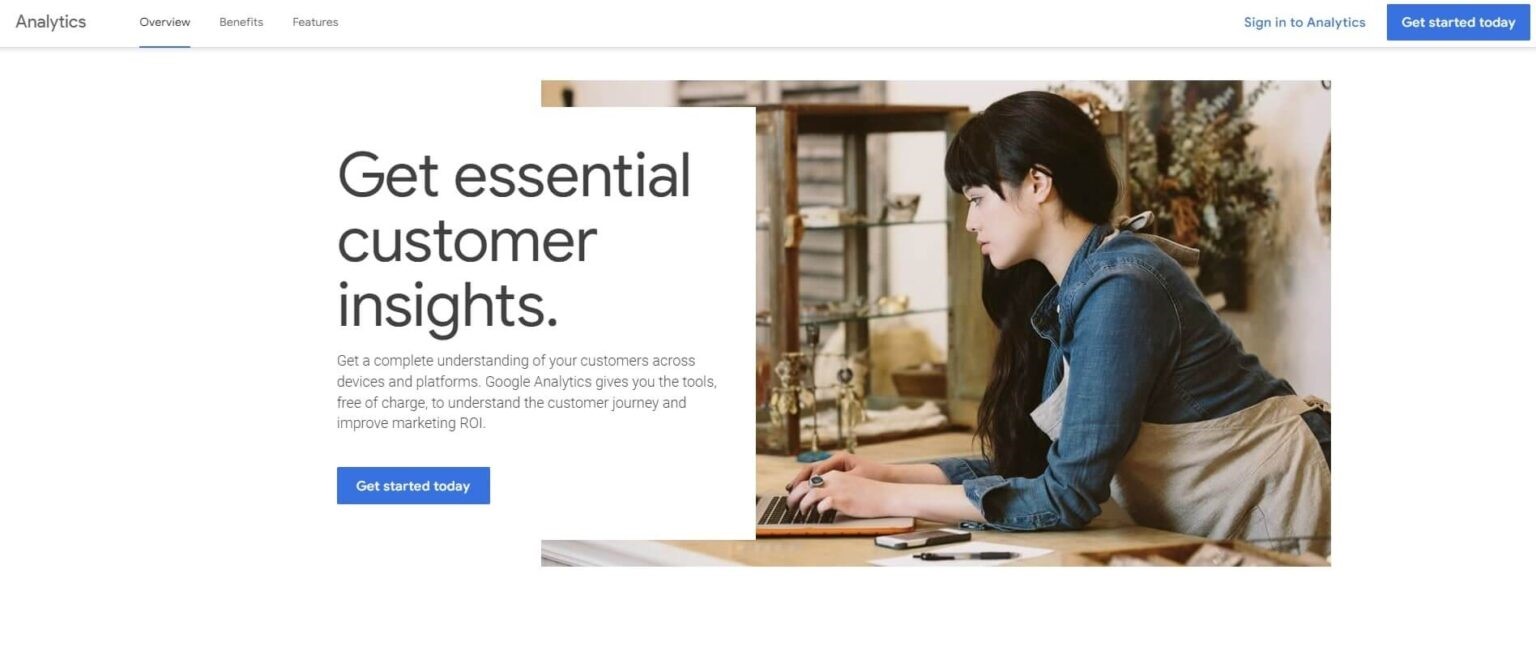
Google Analytics is a powerful web analytics platform that tracks and reports your website traffic, user behavior, and conversion performance.
For ecommerce and dropshipping stores, it’s essential to understand where visitors come from, what products they view, and which actions lead to sales.
The latest version, GA4, introduces an event-based data model, offering deeper insights into the full customer journey across your website (and app, if applicable).
With proper setup, GA4 becomes your main decision-making tool, helping you identify profitable traffic sources and optimize low-converting pages.
Key Features
- Monitor live user activity during campaigns or product launches.
- View demographics, interests, and geolocation to better target your ads.
- See exactly how users find your store, organic search, paid ads, social media, or referrals
- Track events like add-to-cart, checkout, and purchases to build detailed funnels.
- Access metrics such as product views, revenue, cart additions, and checkout steps.
Pros
- Comprehensive, detailed data on user behavior and sales performance
- Free to use for most ecommerce stores
- Seamless integration with Google Ads for advanced attribution
- Custom reports and audience segments for deep insights
Cons
- Steeper learning curve compared to Universal Analytics
- Some user data may be modeled due to privacy regulations (GDPR, ITP)
- Interface and terminology can overwhelm beginners
- Slight reporting delay (most data updates within 24 hours)
Pricing
Google Analytics is completely free for small to mid-sized stores. The enterprise version, GA4 360, is designed for large-scale operations and comes at a premium cost.
For most dropshippers, the free version is all you will ever need to track performance and optimize marketing spend.
21. Heatmap Tools (e.g., Hotjar, Microsoft Clarity)
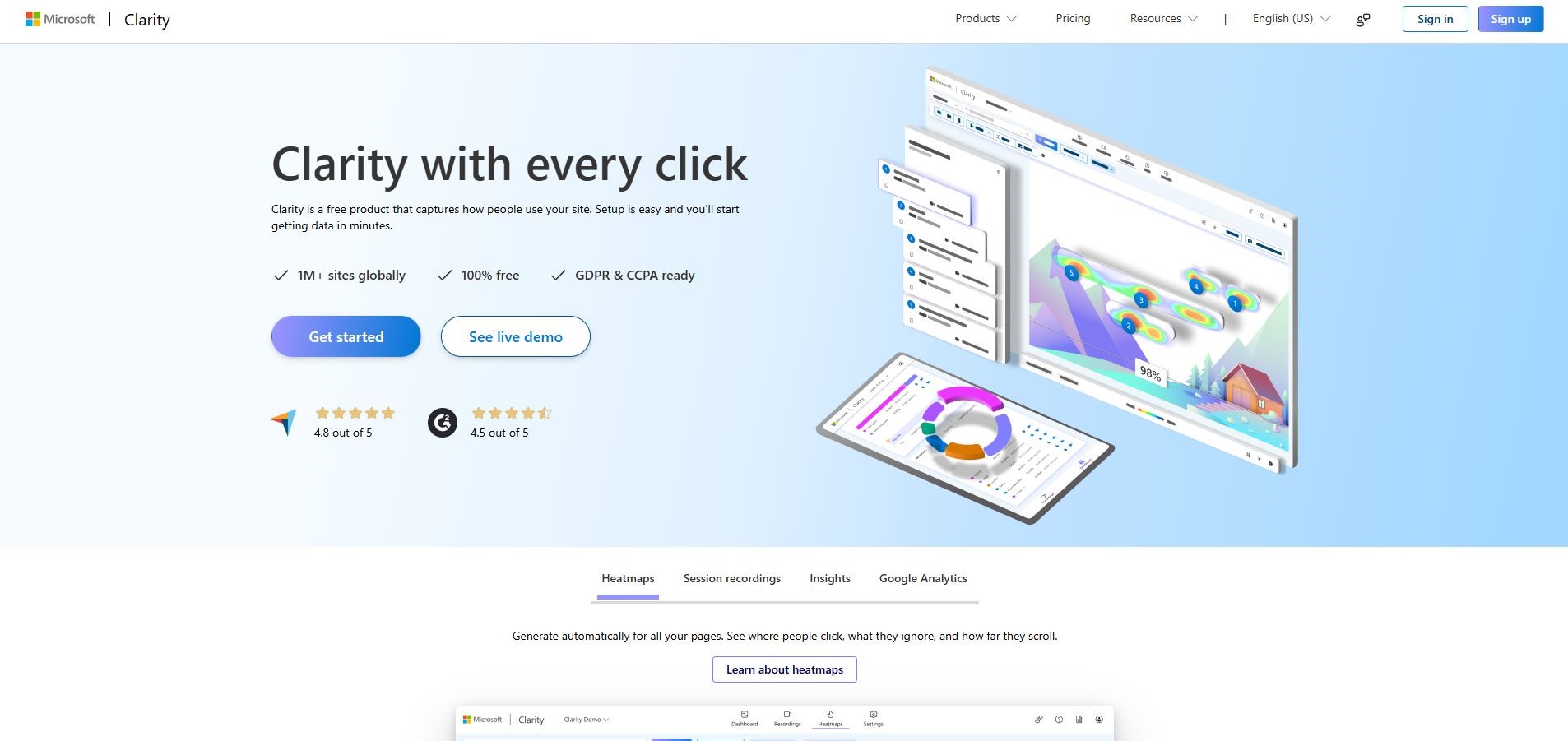
Heatmap tools visually show how users interact with your website, where they click, scroll, or get stuck.
Popular options like Hotjar, Crazy Egg, and Microsoft Clarity help you understand user behavior beyond numbers, revealing what attracts attention and what’s ignored.
For dropshippers, this means identifying design or UX issues that might be hurting conversions, like unnoticed “Add to Cart” buttons or overly long pages.
Key Features
- See which elements get the most clicks and which get ignored.
- Visualize how far visitors scroll to decide optimal placement for CTAs or pricing info.
- Track where users hover their mouse, indicating visual focus areas.
- Watch anonymized user journeys to detect friction points or broken links.
- Identify where users drop off in checkout or sign-up flows.
Pros
- Intuitive, visual understanding of user interactions
- Quickly highlights usability or layout problems
- Drives data-based design and conversion improvements
- Most tools mask sensitive data to stay privacy-compliant
Cons
- Doesn’t show financial metrics, best used alongside analytics tools
- Requires careful interpretation to avoid bias from small samples
- Some tools can slightly impact site load time
- Data may be sampled on high-traffic sites
Pricing
Microsoft Clarity is fully free with unlimited recordings and heatmaps, making it ideal for new dropshippers. Hotjar offers a free tier (about 35 daily sessions) and paid plans from ~$39/month for more data.
Crazy Egg and similar tools follow comparable pricing models. For most small stores, Clarity provides more than enough insight to begin optimizing without extra cost.
Automation and Integration Tools
22. Zapier
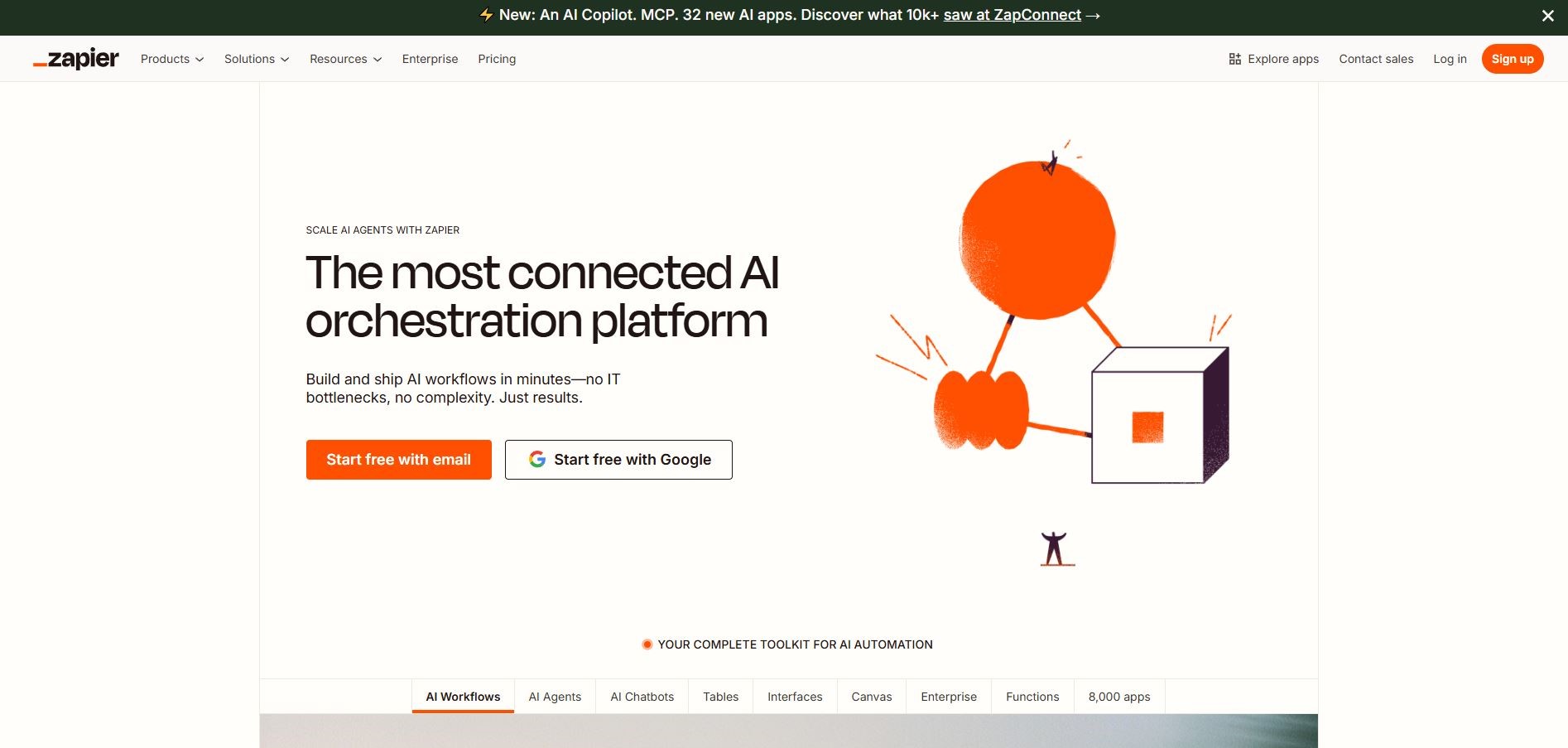
Zapier is a no-code automation platform that connects your favorite apps and services to streamline repetitive workflows.
For dropshippers, it can save hours by automating tasks like syncing order data, sending notifications, or organizing leads across platforms.
By linking tools such as Shopify, Google Sheets, Gmail, and Slack, Zapier allows your systems to communicate effortlessly, no developer required. Each automation is called a “Zap,” built on a simple logic of Triggers (“When this happens…”) and Actions (“…do this”).
Key Features
- Connects 5,000+ apps including Shopify, WooCommerce, Trello, Gmail, Slack, and Google Sheets.
- Build workflows like “New Shopify order → Add row in Google Sheets → Send Slack alert.”
- Chain multiple actions across different tools within a single automation.
- Use filters or “Paths” to run actions only when conditions are met (e.g., if order total > $100).
- Create Zaps through an intuitive interface without writing code.
Pros
- Automates repetitive manual tasks, saving time and reducing errors
- Connects tools that don’t natively integrate
- Scales easily as your business grows
- Active community and extensive template library
Cons
- Free plan is limited in Zaps and task volume
- Requires logical setup, some trial and error for complex workflows
- Dependent on connected apps’ APIs (occasional delays or changes)
- Routes data through Zapier’s servers, privacy-conscious users may review compliance settings
Pricing
Free plan includes 5 single-step Zaps and 100 tasks/month (15-minute update time). Paid plans start around $19.99/month, unlocking multi-step automations and higher task limits.
Professional plans (~$49/month) add faster syncing, conditional logic, and advanced controls. Most small stores can start free and upgrade as task volume grows.
23. AutoDS
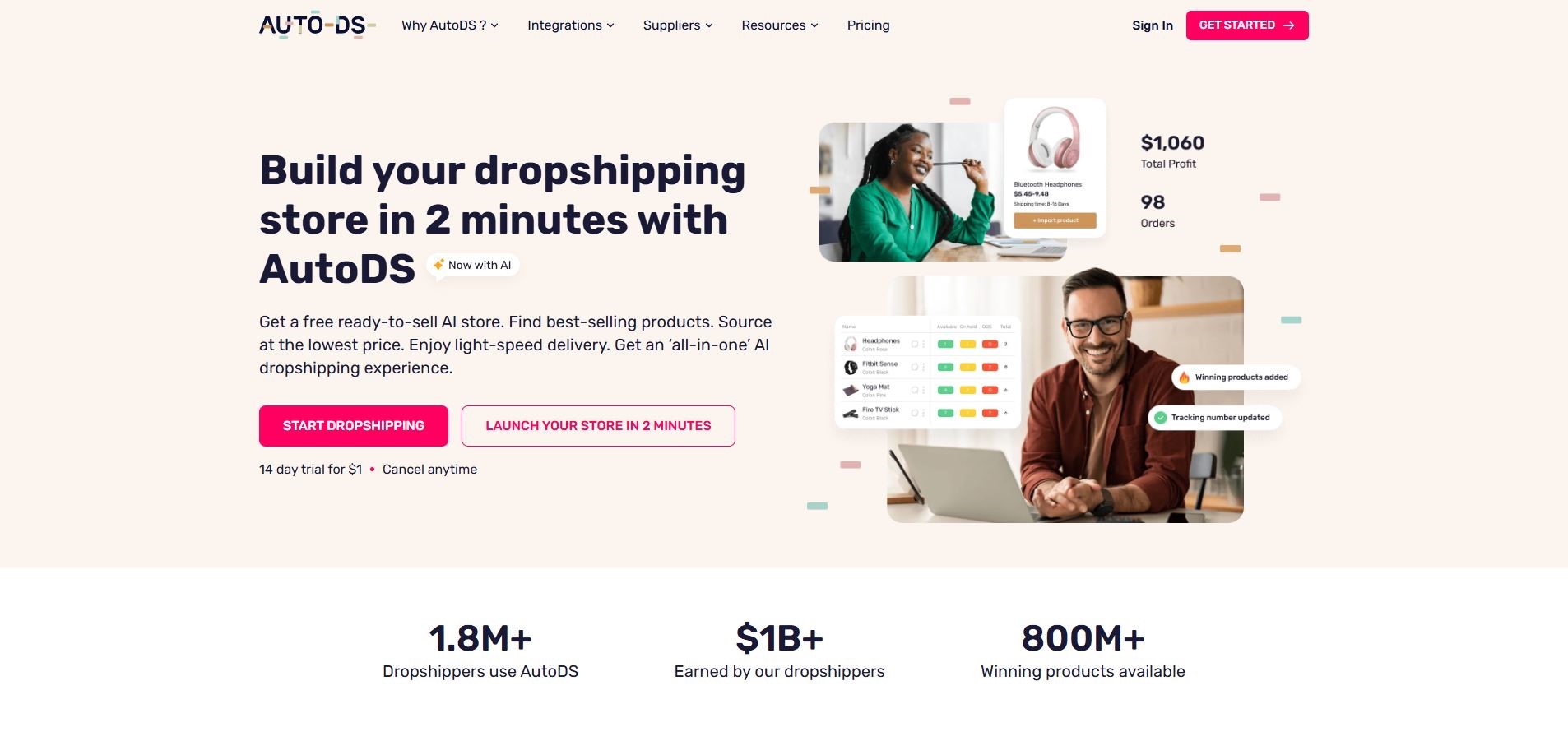
AutoDS is an all-in-one dropshipping automation platform that simplifies product importing, inventory updates, price monitoring, and order fulfillment.
It supports multiple suppliers (AliExpress, Amazon, Walmart, and more) and integrates with Shopify, eBay, WooCommerce, and Facebook Marketplace.
Designed to handle the daily operational workload, AutoDS ensures your listings, stock, and orders stay accurate and up to date, all while minimizing manual effort.
Key Features
- Import products from dozens of suppliers or explore AutoDS’s curated “Hot Products” database.
- Automatically places orders and updates tracking numbers once sales occur.
- Automatically adjusts product prices and availability based on supplier changes.
- Manage all your stores (Shopify, eBay, Wix, etc.) from one dashboard.
- Track profits, sales trends, and inventory performance in real time.
Pros
- Saves hours weekly by automating inventory and fulfillment
- Supports multiple suppliers beyond AliExpress
- Continuously improving platform with new AI tools and optimizations
- Scales efficiently for large product catalogs
Cons
- Subscription cost increases with product volume
- Setup can be complex for first-time users
- Marketplace policies (like eBay’s dropshipping rules) require caution
- Occasional sync delays or order errors, manual checks recommended
Pricing
Plans are tiered by product count, around $14/month for 100 products and $30–$40/month for up to 1,000 listings. Higher tiers support larger stores and additional features like automatic orders or managed buyer accounts.
A $1 trial is often available for new users. While it’s an added expense, AutoDS typically pays for itself by preventing stock errors and automating fulfillment, especially as order volume increases.
Productivity & Collaboration Tools
24. Asana

Asana is a project and workflow management tool that helps individuals and teams stay organized, track progress, and streamline day-to-day operations.
While many dropshippers start solo, scaling often means managing virtual assistants, suppliers, or marketing freelancers, and that’s where Asana shines.
It centralizes all your to-dos, deadlines, and campaigns so you can focus on growth instead of juggling scattered notes and reminders.
Key Features
- Create tasks with due dates, assignees, subtasks, and attachments to manage everything from marketing campaigns to order tracking.
- Organize work into projects by function (e.g., Marketing, Supplier Management) or goal.
- Switch between List, Kanban-style Board, and Calendar views to visualize deadlines and progress.
- Automate repeated workflows like “Update best-sellers” or “Reconcile finances.”
- Assign tasks, comment, attach files, and mention teammates for transparent communication.
Pros
- Brings structure and clarity to complex workflows
- Scales from solo operations to full teams easily
- Keeps everyone aligned with task ownership and deadlines
- Integrates with Slack, Google Drive, Gmail, and more
- Recently added AI tools for task suggestions and summaries
Cons
- Slight learning curve for beginners
- Advanced features (like Timeline, Dependencies) require paid plans
- Too many notifications by default (can be adjusted)
- Subtasks can be hidden from view unless manually linked
Pricing
The Free Basic plan offers unlimited tasks and projects, ideal for individuals or small teams. Premium ($10.99/user/month) adds features like custom fields, Timeline view, and automation rules.
Business ($24.99/user/month) includes advanced portfolio management and integrations. Most small dropshippers can start on the free plan and upgrade once collaboration or automation becomes essential.
25. Trello
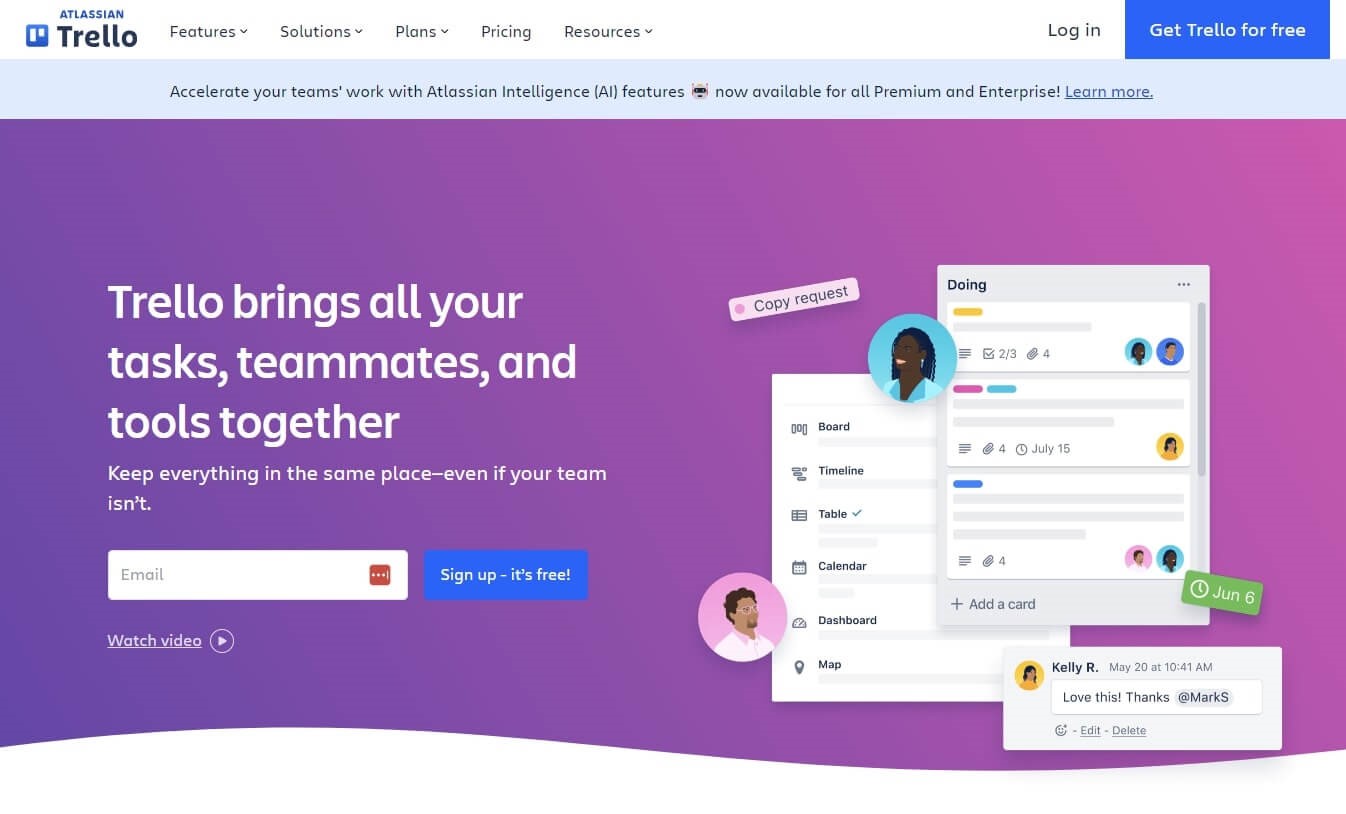
Trello is a visual task management and collaboration platform built around Kanban-style boards. Its intuitive drag-and-drop interface makes it a favorite among small teams and freelancers.
Each task appears as a “card” that moves across columns, perfect for managing marketing calendars, tracking supplier issues, or organizing product research in a simple visual format.
Key Features
- Organize tasks into lists like “To Do,” “Doing,” and “Done.” Move cards as progress is made.
- Add checklists, attachments, due dates, and comments to each card for clarity.
- Assign cards to yourself or teammates for accountability.
- Automatic alerts for deadlines, updates, or mentions.
- Add features like Calendar view, Google Drive, or automation with Butler.
Pros
- Extremely easy to use with no learning curve
- Great visual overview of all ongoing tasks
- Highly flexible for different workflows (content, orders, research, etc.)
- Ideal for collaborating with VAs or small teams
- Free plan is generous enough for most small operations
Cons
- Lacks advanced reporting and task dependencies
- Can become cluttered with many boards or users
- Limited automation on the free plan
- One-dimensional organization, no multi-level hierarchy
Pricing
The Free plan includes unlimited cards, 10 boards per workspace, and basic automations.
Standard ($5/user/month) removes board limits and increases attachment sizes, while Premium ($10/user/month) adds Timeline, Calendar, and Dashboard views.
Most dropshippers can comfortably use the free plan until they need advanced views or heavy automation.
FAQs about Dropshipping Free Tools
In this section, we’ll answer some of the most common questions about starting and running a dropshipping business with free tools.
You’ll learn how to establish your online store, what platforms to utilize, the ideal number of items to list, and the financial requirements to get started.
How to Dropship with Free Tools?
To dropship with free tools, begin by selecting a niche and identifying in-demand products using free research tools like Google Trends.
To set up your online store, use an e-commerce platform such as Shopify, which offers a free trial period.
Free design resources like Canva can help create attractive website visuals.
For order fulfillment and inventory management, explore complimentary apps like Oberlo that integrate seamlessly with your store platform.
Optimize the use of these free resources by regularly reviewing their analytics features to refine your marketing strategies and product offerings.
What Website Do Most Dropshippers Use?
Most dropshippers gravitate towards user-friendly e-commerce platforms like Shopify, WooCommerce, and BigCommerce.
Shopify, particularly, is favored for its simplicity and the array of free apps it provides, which can enhance your store’s functionality.
WooCommerce is an excellent choice for those starting with WordPress, offering numerous free plugins for dropshipping businesses.
BigCommerce is yet another robust platform compatible with various free tools for marketing and supply management.
How Many Items Should I Have on My Dropshipping Website?
When launching your dropshipping website, aim to start with 20 to 50 products. This allows you to offer enough variety to attract customers while keeping your inventory manageable.
Success stories from dropshipping stores reveal that starting small and scaling up with demand is a wise approach. Based on sales data and market research, you can gradually increase your product lineup.
How Much Money Do I Need to Start Dropshipping?
Starting a dropshipping business can be cost-effective, especially if you leverage free tools.
Initially, you may need to invest in website domain and hosting, which can be as low as $30 to $100 depending on your choices.
Incorporating free dropshipping tools for product sourcing, order fulfillment, and analytics can immensely lower the costs.
While some successful dropshippers began with a few hundred dollars, using free tools wisely can significantly reduce your startup expenses.
Wrapping Up: Making the Most of Free Dropshipping Tools
Running a successful dropshipping business today isn’t just about finding the right products, it’s about building the right system.
From sourcing platforms and automation tools to analytics and productivity apps, every tool you add to your stack helps you work smarter, save time, and scale faster.
Whether you’re just starting out or optimizing an established store, the key is to choose tools that truly fit your workflow, ones that automate repetitive work, give you insight into performance, and make collaboration seamless.
The more efficiently you operate behind the scenes, the more time you can spend growing what really matters: sales, brand, and customer loyalty.
For a seamless dropshipping experience, remember to request a free sourcing quote from us at NicheDropshipping. It’s a simple step towards elevating your e-commerce business.
